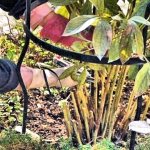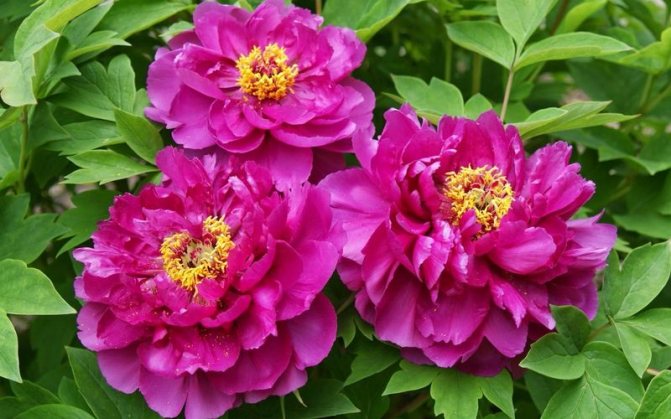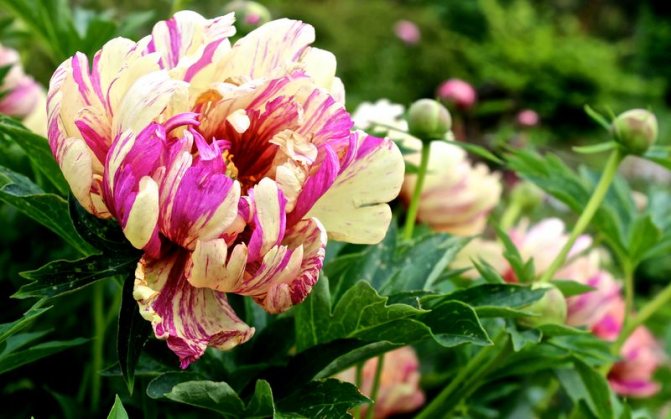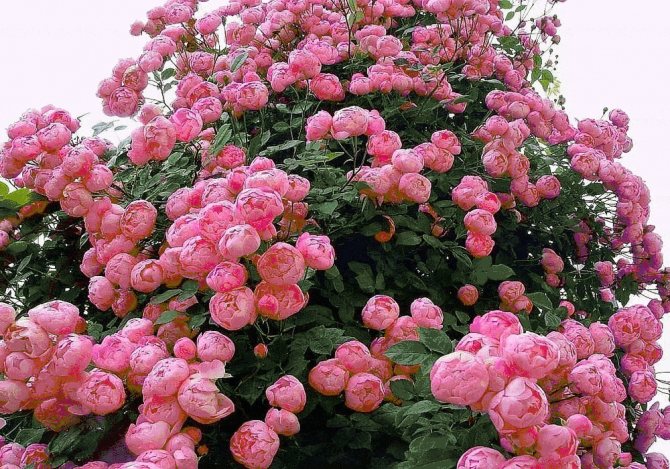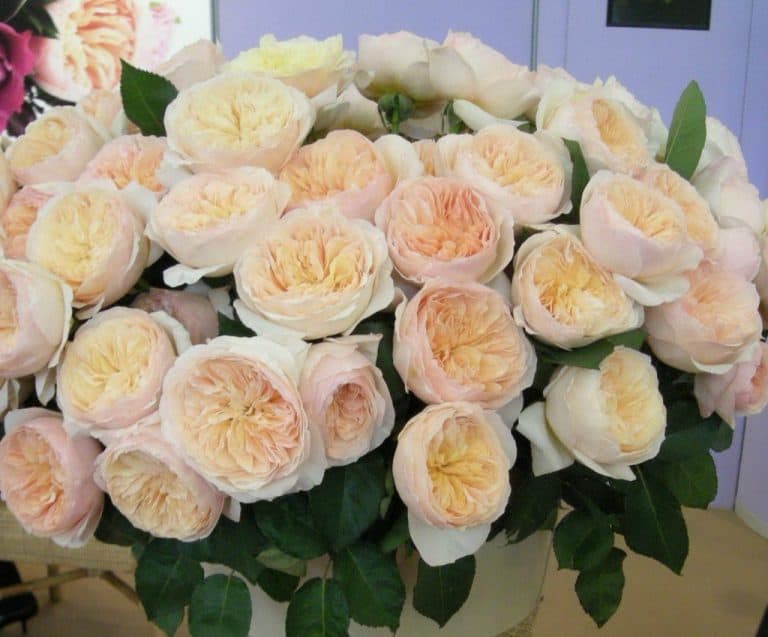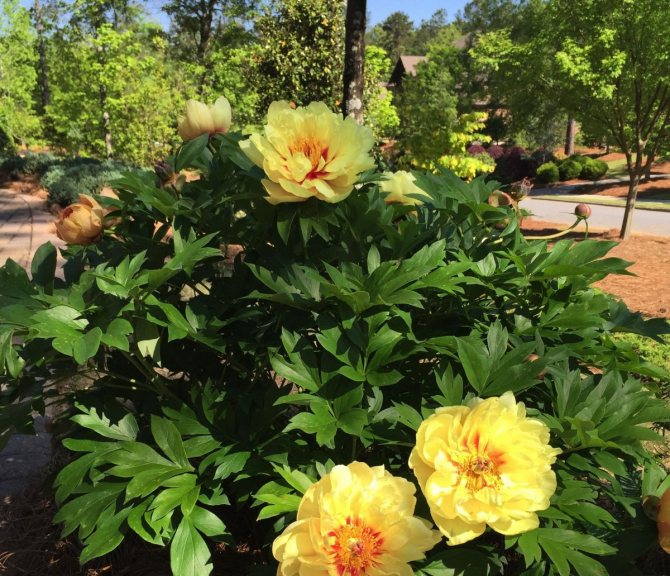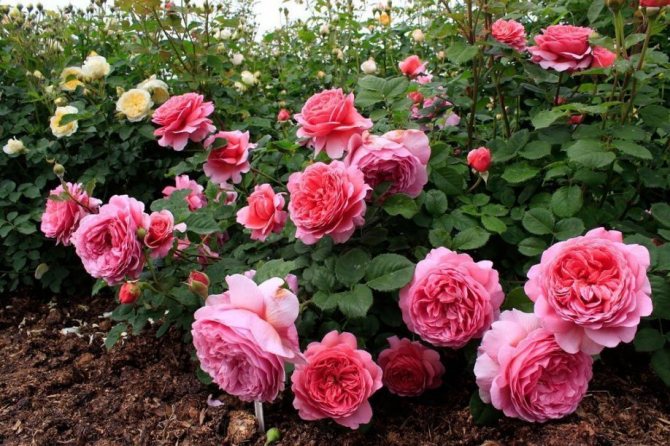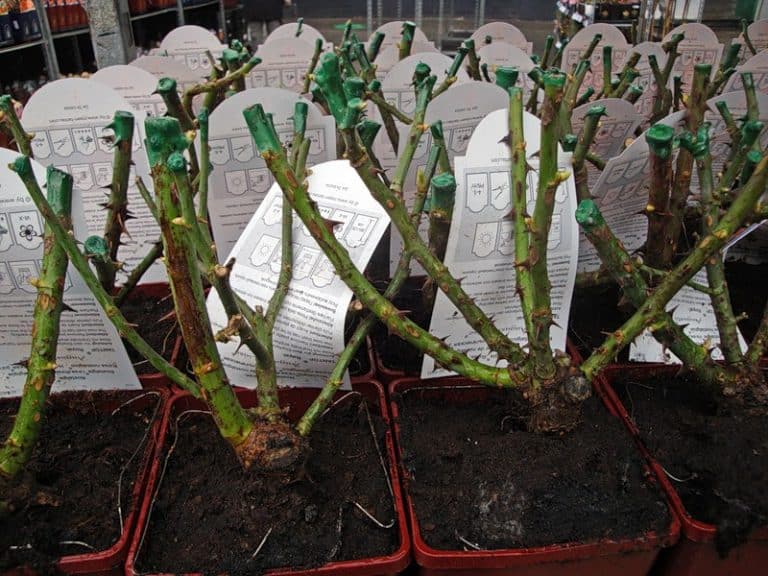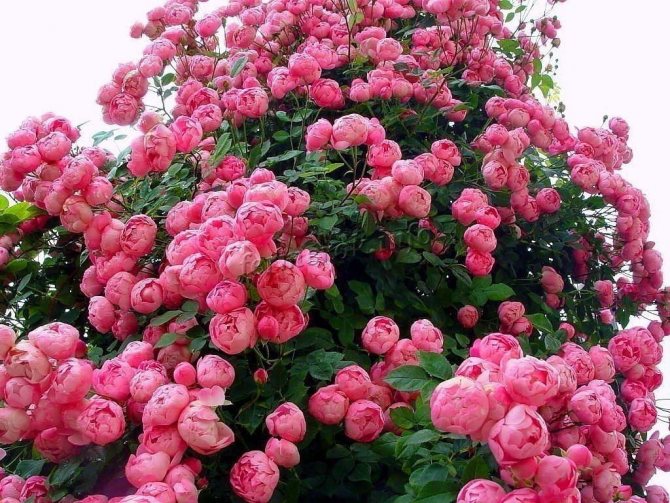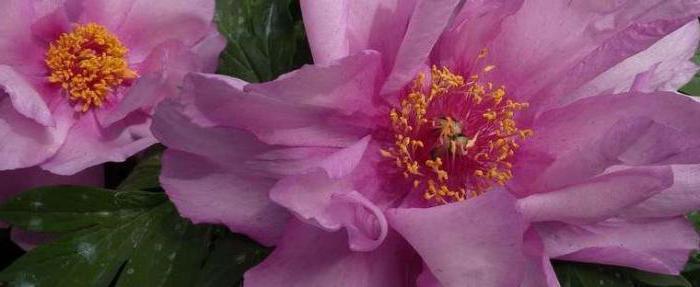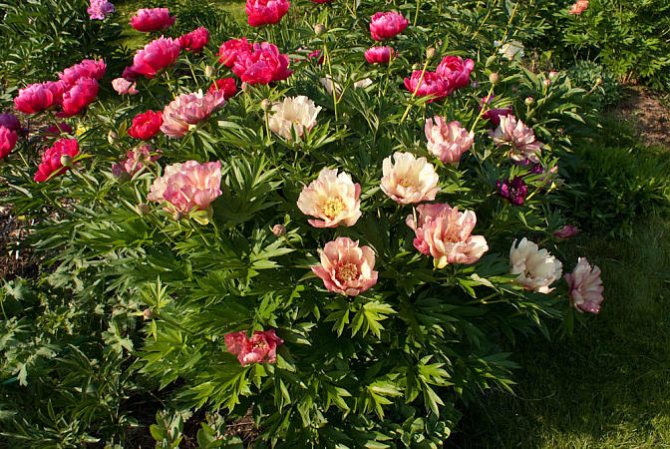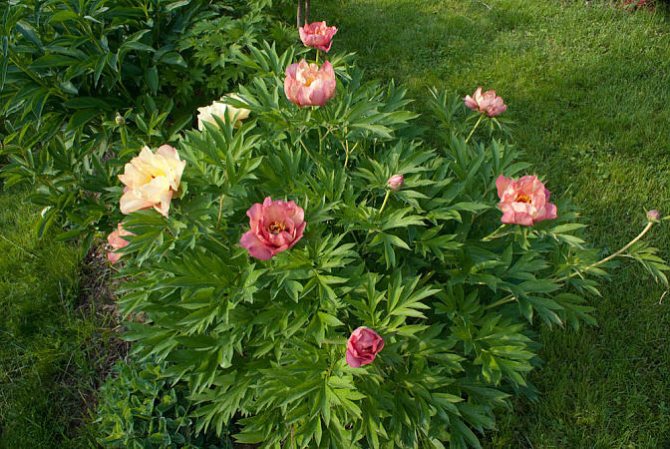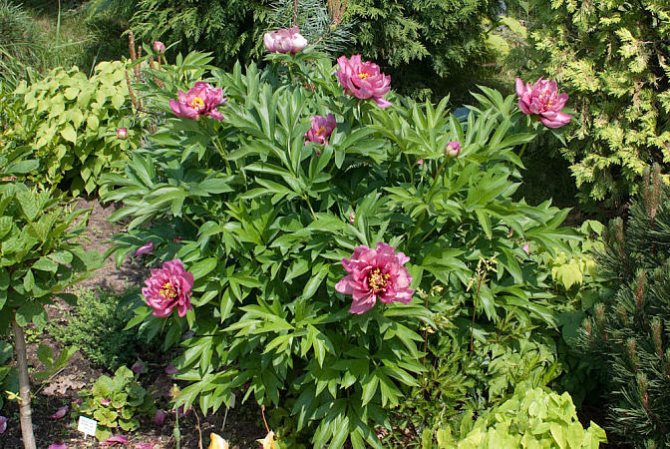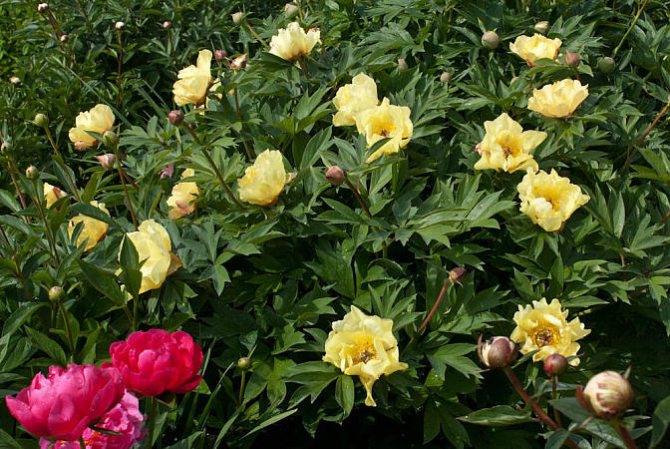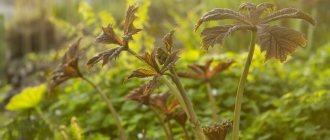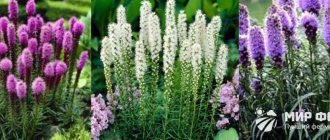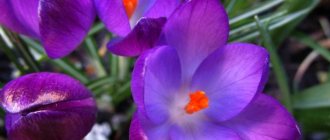Ito-peonies, or peonies-hybrids (Itoh-hybrid), are a complex species that is obtained by crossing varieties belonging to different climatic zones: from Transbaikal to Tibetan. This origin determines their properties:
- frost resistance;
- unique coloring;
- powerful growth;
- abundant flowering;
- developed root system;
- vegetative reproduction (dividing the bush);
- well-developed kidneys.
But they do not tolerate heat well and cannot provide themselves with the required amount of moisture on their own. Therefore, you should always monitor the soil moisture, ensuring timely watering.
Soil for planting, care
For planting peonies, it is advisable to choose places with loamy soil, where there is a neutral level of acidity. To bring the soil closer to sandy soil, you need to add peat, humus and sand, wood ash to it. Peonies are transplanted in early autumn or late summer. To do this, it is necessary to prepare a planting hole in diameter and depth of about 70 cm. If several bushes are transplanted, then the distance between them is 1.5 meters. A little sand, crushed stone and broken brick are poured into the bottom of the pit. The layer of this filling in the planting pit is about 15 cm. The next stage is the introduction of organic and mineral fertilizers. To obtain them, humus and compost, a little lime, superphosphate, potassium sulfate and wood ash are mixed. Next, the planting hole should be half filled with garden soil and compost mixed in equal amounts.
After 10 days, the soil will sag and you can start planting peonies. To do this, the root of the bush is placed in a hole, covered with earth and tamped a little. It is strictly forbidden to plant peonies very deeply, otherwise the bush will have gorgeous leaves, but no buds.
When planting peonies, you need to pay attention to the fact that the upper growth point is a maximum of three centimeters deep.
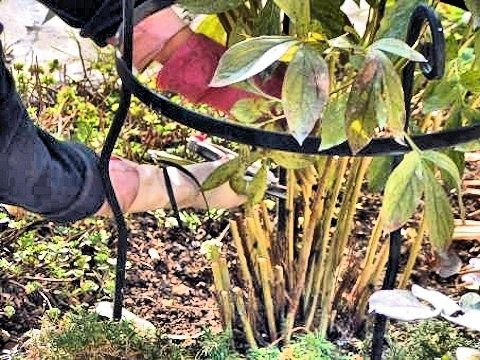
Sometimes, after planting, the bush takes on a withering appearance and does not bloom in the first year, but this is a common occurrence, since it must fully recover from stress. With good care, it blooms in the second year. Some of the best varieties of peonies tolerate transplanting less painfully and do not stop flowering. In the spring, a transplant is undesirable and is carried out only in rare cases. For example, you need to expand the flower bed, equip paths, make an extension, that is, when the bush gets in the way and must go to another place of residence.
The next important point after transplantation is the care of ITO peonies, since the plant should not dry out. If the peony is in a large flowerpot, then for the winter it is usually brought indoors and stored until spring. When it gets warmer and there is no threat of frost, the bushes can be planted in a flower bed. But this only applies to young bushes, which still do not tolerate frost well. Taking into account the transplanting season, the care for the flower may differ slightly.
How to prepare for landing?
Preparing a peony for planting is the initial stage of growing a plant, which requires care and accuracy, since the final result depends on it.
First of all, you need to choose a seedling. Here are some guidelines to help you avoid mistakes when choosing.
- It is better to purchase peonies for planting in the fall, since such plants probably already have a formed root system.Be sure to pay attention to the packaging of the peony: the roots should be in a pot or box with soil, and also be extremely moist. Such plants should be planted no later than three days after purchase.
- In the spring, you can also buy seedlings, but you need to inspect them more carefully, since spring plants are weaker and have a root system more susceptible to external conditions. The seedling must be inspected for damaged stems, leaf spots or dried roots. If any of the above is noticeable, it is better to refuse to purchase such planting material.
Having decided on the choice of a seedling, you can proceed to the next stage - the preparation of the planting site. In order to properly plant a plant, you need to know that peonies love open sunny areas. The presence of a slight penumbra is allowed, but some varieties of this culture react negatively to it. It is also undesirable to plant peonies in swampy areas. It is better to give preference to small hills or to make an embankment in the garden on your own.
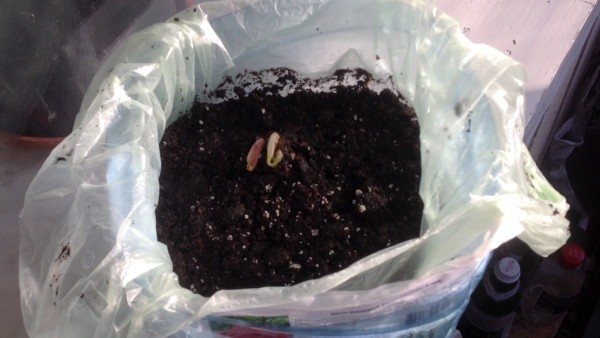

When planting, pay attention to the surrounding plants and structures. Peonies should not be placed next to objects from which water often flows, so that moisture does not stagnate at the roots of the shrub.
As for the variety of soil, Ito-peonies are unpretentious to it and can grow in any soil, except for one variety - marshy. Also, the soil should not be acidic, otherwise the plant will wither or grow very weak.
After completing all the preparations and making sure that everything is done correctly, you can proceed directly to planting.
ITO - peony hybrids: varieties for growing on the site
ITO peonies belong to intersectional hybrids that have become something between a tree and a herbaceous species. According to their external characteristics, these hybrids have signs of herbaceous and tree-like groups, therefore, the description of ITO-hybrids of peonies can be completely different. Each year, their aboveground part dies off, and in the spring it is renewed again. They also have stem-like, fleshy tubers, the growth of which can reach up to 100 cm. The flowers of the hybrids are rather large, single, can be simple, double and semi-double. Their colors are also different: red, white, pink, and even there are yellow ITO peonies, which are very rare. There are such types: Pastel Splendor, Kenari Diamonds, Border Charm, Garden Treasure, Moning Lilak, Corporal, Yellow Lace, Gold Mine, Old Rose Dandy, Vision of Suga Plume. Below are the most famous ITO-hybrids of peonies: varieties, their brief description and recommendations on how to plant.
Peony Garden Treasure
This is an American variety of peonies that pleases the eye with its large yellow flowers; at the base, the petals have acquired red spots. Moreover, the Garden Treasure peony has a pleasant smell, a dark green leaf and large branches, the height of which can reach 120 cm, the bush is about 150 cm wide.If this is an adult Garden Treasure - ITO peony, then it forms more than 50 huge buds and is distinguished by long flowering ... This variety has received many international awards and belongs to the medium late variety.
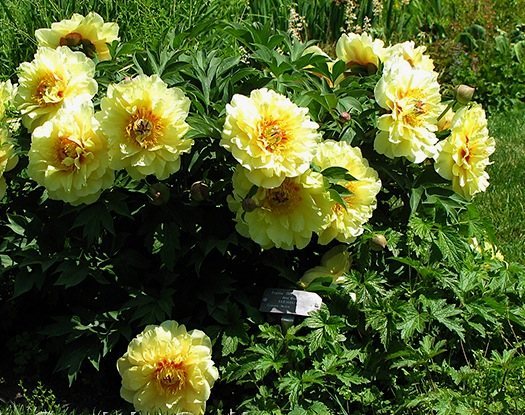

Peony Garden Treasure
Peony Hillary
This hybrid has large double flowers, the diameter of which is up to 20 cm. When the ITO Hillary peony just begins to bloom, its flowers are bright pink, and then every day they acquire a pale pink hue. In the center, the flower has a cherry color, the leaves of the bush are dark green, dense. The buds give off a pleasant aroma and bloom singly, which prolongs flowering and creates the presence of several shades of flowers. Thanks to this, such ITO-hybrids of peonies are called chameleons.
Peony lollipop
Quite bright, variegated variety, as it has pale yellow flowers. Purple and red strokes are scattered over all the petals, which makes the ITO peony Lollipop a real masterpiece.The bush itself is tall, rounded, gives many lateral buds, and blooms in early summer. The Lollipop peony is no more than 80 cm high.
Peony Scarlet Haven
A very rare, unique variety with two rows of buds, flower petals in a bright red hue, which gives them the beauty of silk and velvety. In the center of the ITO, the Scarlet Haven peony has a mass of short stamens, from which a dense ring is formed. The blossoming buds are no more than 15 cm in diameter, they have a pleasant aroma and a beautiful bright color. The peony bush is very lush and can reach a height of 70 cm, its foliage is so dense that it covers almost all bare branches, revealing only its flowers.
The first flowering of this peony begins in April and ends in May. Therefore, it is considered early. Peony flowers are very lush, bright with a yellow tint and red strokes at the base of the bud. They are 20-25 cm in diameter and bloom singly, which increases the flowering period to four weeks. The flowers have a pleasant, sweet aroma and can stand in a vase for a long time after being cut. In height, the ITO-hybrid Bartzell peony can reach 80 cm, but it grows more in width. Its leaves are dense, dark green, but by autumn their shade becomes bronze, therefore the Bartzella peony belongs to the decorative varieties. This species is ideal for backyard landscaping and is grown for cutting.
Peony Lois Choice
A beautiful, luxurious flower that belongs to interspecific hybrids. Lois Choice peony has huge, double flowers with double color. Each shade is divided into three sections; they are pink, creamy yellow and pink. The bush reaches a height of 75 cm and belongs to the mid-early group. Its foliage is quite bright and contrasting compared to the flowers. Lois Choice peony blooms profusely and for a long time, suitable for cutting and garden decoration.
Peony Pink Hawaiian Coral
The flowers of this peony are 16 cm in diameter, in full disclosure their color changes to light coral, and initially it is a bright coral color that immediately catches the eye.
In the middle of the bud, there are many yellow stamens, which make the flower as beautiful as possible. The Pink Hawaiian Coral peony is about 80 cm high, quite strong and with dense foliage. This variety belongs to the early ones, as it is strewn with flowers already in May. It is used for garden decoration or for cutting.
Peony Pink Hawaiian Coral
Peony Julia Rose
A beautiful American peony that produces luxurious, silky flowers. The color of the buds changes after the blooming of the petals: at first they are dark red, then deep pink, and then turn yellow. Sometimes flowers take on three shades at once, which makes them truly unique. The peony Julia Rose is 90 cm high and belongs to the middle honeycomb.
Peony Yellow Crown
The bush is small in height, only 60 cm. Its flowers are double or semi-double with a bright yellow tint and red strokes at the base of the petals. The buds give a fragrant smell and are quite large in size. The Yellow Crown peony is planted in a warm, sunny place, and it also does not tolerate a transplant. For abundant flowering, the bush should be transplanted in such a way that 5 cm remains above the ground surface. The variety is medium and blooms two years after transplanting.
Peony Collis Memory
Collis Memori peony blooms in May-June, it stands out with large flowers of a gentle yellow color. The petals of the buds are soft pink at the edges, and cherry-colored at the base. When the bud has fully blossomed, it becomes almost flat, and is about 20 cm in diameter. The flowering of the bush lasts no more than 20 days, its height is about 1 meter. The bush itself is sprawling, green and does not lose its beautiful, decorative appearance throughout the entire period of growth, therefore it will become a wonderful decoration of the garden in the warm season. Suitable for cutting and decorating gardens and adjoining territories.
Peony Cora Louise
This variety blooms from April to mid-May, forming large, luxurious white-pink buds. At the base, the flower has a purple-burgundy hue, which makes it sophisticated and interesting. Bright, yellow stamens, which are completely open after budding, add beauty to the flowers. The flowers of this variety are large - up to 25 cm in diameter, have a pleasant aroma and open wide. The flowering of the bush lasts a maximum of 4 weeks. Peony Bark Louise is up to 90 cm high, strong flower stalks do not require additional support, despite such large buds. Peony foliage is lush, has a rich green color and does not lose its decorative appearance until late autumn. This variety is readily grown for cutting, since the buds can stand in a flowerpot for up to 10 days. A hybrid peony is planted in any soil, but it is desirable that it be fertile, with sufficient nutrients. The peony does not need special care and can withstand severe frosts.
How peony hybrids are planted
Despite the fact that the hybrids were bred in distant Japan, patented in the United States, they grow successfully in our open spaces. Of course, each region has its own subtleties of cultivation, which are presented by ito-peonies. The best varieties for the Moscow region may not bloom so abundantly in Transbaikalia, and the southern climate of the Kuban is suitable for the most capricious varieties. We have cultivated hybrids for a sufficient number of years to say unequivocally that they are suitable for growing in the gardens of lovers of these wonderful flowers.
Growing plants in the Moscow region will most likely require shrubs to be insulated for the winter. For this purpose, spruce branches, tarpaulin or straw huts are standard.
Requirements for soil and site
In order for peonies and ito-hybrids to grow well on your site, a description of the requirements for soil and agricultural technology must be read. Gardeners must know that the soil on the site should not be acidic. The best option is a value within 6-7 units. If you know that your soil is more acidic, it is advisable to add slaked lime or bone meal to it while preparing the soil for planting.
Another important point is that there should not be a close location of groundwater at the planting site of the peony alleys, otherwise the bushes will get wet, they will rot and hurt. Plant roots deepen by a maximum of 90-100 cm - this is the level that is permissible for the passage of groundwater.
Planting process:
- the purchased bush is carefully examined for the presence of diseases, pests and is etched for prevention with vitriol, an available fungicide, or at least a solution of potassium permanganate;
- a hole is prepared at the site with a depth of 90 cm and 60 cm around the circumference;
- a layer of drainage is poured onto the bottom - crushed stone or broken brick;
- the soil dug from the hole is mixed with sand, peat, bone meal or wood ash and a layer is poured on top of the drainage;
- some time must pass between the preparation of the hole and the landing for the soil to settle;
- then place the bush and cover it well with soil, compacting on the sides;
- after planting, the hole is watered abundantly and more earth is poured on top;
- the planting site is mulched around the circumference with straw (in spring) or a dead leaf (in autumn).
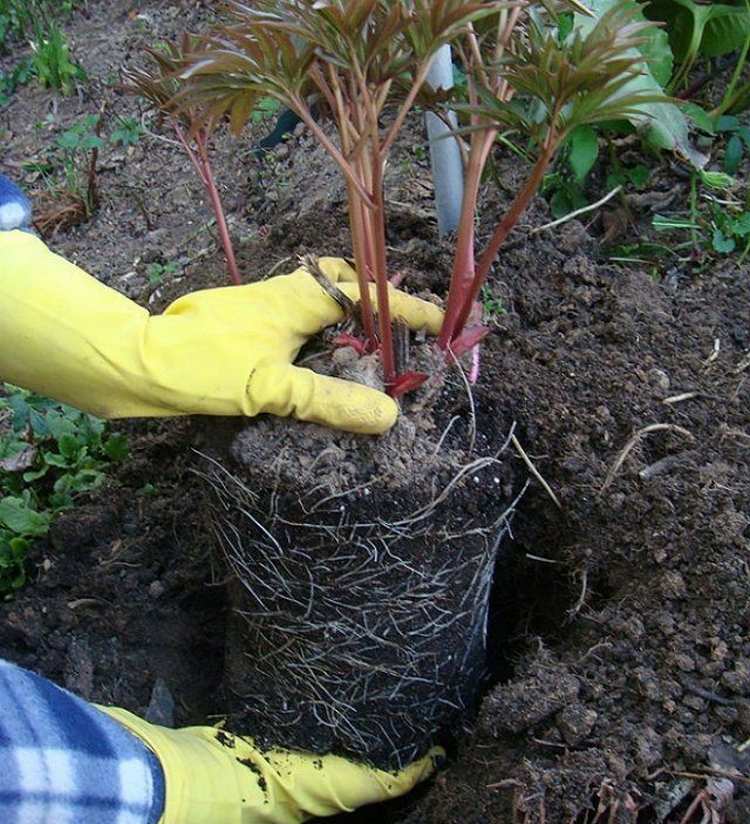

Peonies ito-hybrids - planting
For hybrids, sunny places with shade in the afternoon work well. Peonies should get enough light; in the shade of houses or large trees, they do not bloom well. It will be useful to know that many gardeners refuse to plant bushes in the same place of other peonies, bushes or trees. In that place, the soil may be depleted and unsuitable. Bushes grow best in place of vegetables and legumes, or after cereals.
The best time to disembark
Just like herbaceous specimens, hybrids should be planted in late summer, closer to autumn. So they will take root well and take root over the winter, and in the spring they will release their first buds. This is true for the middle lane, for the Moscow region.In warm climatic zones, peonies can also be planted in spring. It is advisable to carry out this procedure before the onset of heat. It is necessary to strive to make a planting before May, so that the young seedling grows immediately.
A small bush can be planted at an angle so that the buds are on top. When planting, they are sprinkled with a small layer of soil - no more than 5 cm.
If, when buying, you got a rather large bush, it can be immediately divided into two or three parts. Such seedlings will immediately begin to build up the root system, which in the future will allow them to form strong plants. A large bush can exist for a long time due to the accumulated nutrients in old roots, while it will not release young roots for a long time. In the future, such a bush may lag behind in the number of buds and in development as a whole.
When planting young seedlings of ito-hybrids in the fall, many growers are afraid of burying the buds during the winter period. After all, if the soil in the planting pit has not settled too much, then the unrooted bush can easily sag under the pressure of snow and melting water. And if the buds go deep, then development and flowering will come much later. The way out of this situation is very simple. During planting, a strong peg is placed across the pit. A bush is tied to it by the stems so that the distance to the upper bud is about 5 cm. The bush is added dropwise together with a peg resting on the edges of the pit, and left so until spring. Such an adaptation will prevent the bush from failing and will ensure good flowering in the future.
Agrotechnics
Below are some basic information on boarding.
Boarding time
The best time of the year for planting is autumn. It should be expected that there should be a month before frost for the plant to take root.
Note! Planting a peony seedling is done in the morning or in the evening. If you plant in the morning, then you should wait until the evening with watering.
Peony planting soil
The soil is suitable either sandy loam or loamy. Groundwater must run deep. Minerals must be present in the soil, otherwise fertilizers must be added.
Land suitable for planting
The planting site must be well lit, direct sun exposure to the flower is unacceptable. The place must be open. It should not be planted in the shade, as the flower will not receive the necessary sun for a beautiful bloom. It is not recommended to plant in low places, the best place is on a hill. The site is chosen immediately as a permanent place for a flower. The peony will bloom at 2-4 years of age.
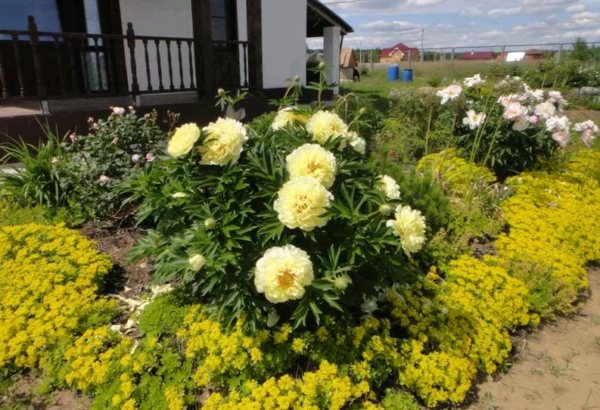

Pick-up location
Seedling preparation
Seeds are not used for planting, since the plant is a hybrid variety. It should be planted by the root. There are two planting options: buying a ready-made seedling or dividing the root of an existing plant.
If a flower seedling is purchased, then it is necessary from a quality and trusted manufacturer. During the inspection, special attention is paid to the presence of rot, damage and holes from pests. You should buy healthy, resilient tubers with 2-3 buds in order for the plant to resume growth. If there are 4-5 buds on the planting material, then this is the key to good survival. The number of buds is desirable to match the number of roots. Stripping is carried out before landing. It is necessary because the roots are stored for a long time, and rot and mold are formed on them. The stripping procedure involves removing the trouble data with a knife. Cutting points are treated with ash. Next, soak the tubers for an hour in a manganese solution for disinfection.
Note! Purchased seedlings are planted in mid-spring, and the root obtained by dividing is planted in August.
Planting process
The root system is branched, therefore it is necessary to prepare a pit, the dimensions of which must correspond to the following parameters: depth - 70 cm, width - 70 cm.
Important! The soil must be treated with manganese, since the solution has disinfecting properties.
Prepare drainage to the bottom of the pit.Drainage is expanded clay, small stones, small pieces of brick. The next day, all this is laid out in a hole in a layer of up to 10 cm. Then layers of sand and peat are poured, each 5 cm long. The next 10 cm, a layer of fertilizers (manure or superphosphate) is laid out. Plant roots in the resulting hole. If the hole is too deep, add another layer of soil after fertilization. Sprinkle on top with a mixture of ash and sand. This measure is needed in order to prevent the appearance of rot. Pour the seedling with 8 liters of warm water. After all the procedures, the soil around the root is mulched with peat.
Note! When planting, the buds should be located at a depth of no more than 5 cm.
Care
The peony is unpretentious, but for a better appearance, it is necessary to follow some measures for caring for it.
Top dressing
Fertilizers are used for feeding. They are brought in 4 times:
- in the spring, after the mulch has been removed, it is necessary to feed with nitrogen (for the rapid growth of greens);
- when forming buds (complex fertilizers);
- during the flowering period - potassium chloride and superphosphate;
- before frost.
Important! Do not overdo it with fertilizers, otherwise there is a risk of getting too abundant greens, but few flowers. Top dressing should be applied following the instructions for them.
Loosening, mulching
Loosening is carried out during dry periods and after heavy rains. The soil should be loosened frequently. Weeds interfere with flower growth and should be removed.
Drafts
Since the peony has a tree-like stem, it is not afraid of winds and drafts. Cases of breakage of such a stem are rare.
Watering
Watering should be done in the evening, 1-2 times a week, but in case of rare rains, increase the number of waterings up to 3-4 times. If it rains heavily, then watering is postponed for 3 days. The amount of water for watering an adult plant is 10-15 liters. In the autumn, the flower should not be watered.
On a note. Large moisture is contraindicated for a flower, therefore, it should not be placed near artificial reservoirs.
Irrigation and spraying
Additionally, you should not spray the plant during a rainy summer period. But if the summer turned out to be hot and dry, then irrigation and spraying will not be superfluous.
Pest control
The main pests are spider mites, aphids, and ants. To get rid of them, insecticides are used. But, as a rule, the flower is not susceptible to pests as well as diseases.
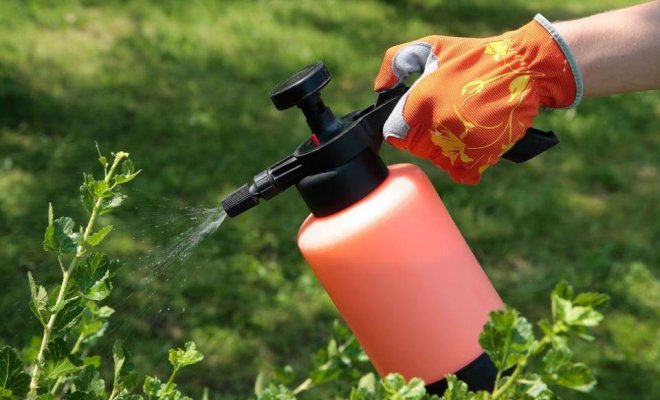

Pest control
Transplant, pruning
Transplanting is carried out as a last resort because the procedure is stressful for the plant. It is done in the fall.
All the stems of the plant should be completely cut in autumn, leaving 8 cm above the ground. Do not be careful with pruning (you can cut to the level of the soil), the plant has buds on the roots to resume growth, so that new shoots will appear in the spring. A dry day should be chosen for pruning to protect the plant from rotting. During the flowering period, in summer, they are pruned as they bloom so that the decorative appearance is preserved. In the first years of life, you should pick off the buds, which will help the bush to get stronger.
Note! When transplanting, the roots of adult plants need to be divided, since they tend to clog each other.
Wintering
Bartzella tolerates frost and temperature extremes. But with the first frosts (-3-5 degrees), young plants must be covered with mulch (peat, garden soil, sawdust) or spud higher. In the spring, when the temperature is stable (-3-0 degrees), mulch should be removed. This is necessary so that the buds begin to grow, and the root does not overreach.
Reproduction
Reproduction is done by dividing the bush. You can only divide the root on a plant older than three years. The recommended time for the procedure is from August to October.
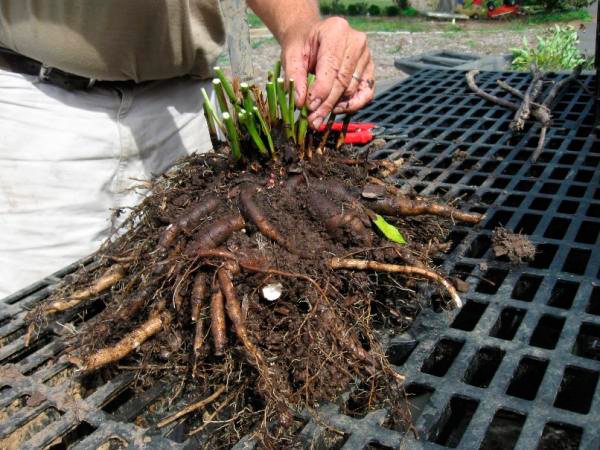

Reproduction
How to divide the root:
- The root is dug up.
- The part with the kidneys is cut off.
- The place where the cut was is treated with manganese and dried.Planting a bush in the old place.
- The resulting seedling is also processed with manganese. Then he lands in a permanent place.
Important! In order not to destroy the plant, it is necessary to take into account the fact that the root system is well developed, but it grows shallowly into the ground. If it is damaged, the plant will die.
How to plant: step by step instructions
Step-by-step instructions for planting peonies will come in handy even for experienced gardeners. To avoid mistakes and plant the plant correctly, we recommend following our advice.
- First, prepare your seedlings. If you use flowers in pots purchased for seedlings, then before removing them, the soil must be moistened in order to release the roots without damage to the plant.
- The next step is to prepare the planting pit for the bartzella peony. It must be dug out in advance so that the soil can be saturated with oxygen. The depth of the pit must be at least forty-five centimeters, and the radius must be at least seventy-five centimeters.
- At the bottom of the finished pit, it is necessary to lay out a drainage layer, which will prevent excess moisture from entering the roots of the plant. It is better to use fine gravel or sand for this purpose.
- The next layer should be a mixture of fertile soil with mineral fertilizers. It needs to fill the pit by about two-thirds.
- Now you should plant the seedling in open ground. This must be done in such a way that the buds of the plant are at the same level, and also sunk into the ground by no more than five centimeters.
- If a seedling is planted from a pot, it should be lowered into the hole along with the soil in which it grew.
- Cover the planted peony with earth and compact it on top with your palm.
- Water the plants, allocating a bucket of water for each plant.
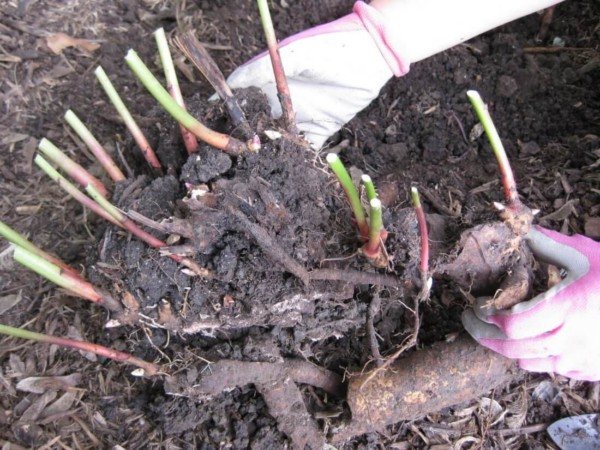

After the peonies are planted, the soil under them should be mulched to slow down the evaporation of moisture. For the next few weeks, until the roots take hold, the crop needs to be cared for properly.
History of origin
Everyone knows that China is considered the birthplace of peonies: it was here that these flowers were grown for a long time, and breeders were able to breed a variety of species. When the Chinese developed the herbaceous form, they sent flowers to Japan. There, the peony also fell in love and Japanese breeders began to develop their "Japanese" flower shape. As a result, they managed to bring out a yellow peony. And in America in 1986 they went even further and brought out a hybrid.
Despite this, the Japanese professor Toichi Ito still developed his Ito hybrid. Most of them died, but about 30 seeds remained, which are now the progenitors of the famous peony. Ito peony is a herbaceous plant, but the lower part is still tree-like. With the onset of cold weather, the upper part of the peony begins to die off, but the lower one still continues to live, so the flower is perennial.
The yellow color of the Ito hybrid is traditional, but scientists continue to breed hybrids of other color schemes, such as lilac, raspberry, apricot and white. A scientist from America, on the basis of a Japanese hybrid, was still able to breed his hybrid and gave it the name Bartzella's peony.
Ito hybrids were obtained thanks to long and painstaking selection, because as a result of 1200 attempts of crossing, only 36 seeds were obtained, and of them only 9 were able to give roots. At the same time, the main goal was achieved - to get a yellow hybrid peony. But the Bartzell hybrid is the creation of the breeder Andersen. The flower participated in exhibitions and was recognized as an unsurpassed creation, therefore its price is high.
We also recommend reading:
Yellow Aspen hybrids
Yellow roses are a symbol not only of imminent separation, but also of friendliness and happiness. There are many peony roses of this shade.
Graham Tomas
Roses Cordes
A variety with medium-sized double flowers, which make up 5-6 inflorescences. The color of the petals is bright yellow, saturated. The scent of the rose is pleasant, but weak.
Graham Thomas bushes reach 1.5-3 m in height.The hybrid is resistant to infections and cold temperatures, which explains its popularity.
For your information! Graham Thomas ranks among Austin's finest rose varieties. Blooms all season.
Golden Celebration
Rose Golden Celebration is a tall, spreading variety with large, strong-smelling honey-colored buds. The diameter of the flowers is 16 cm. The flowers form clusters of 5-6 buds.
Hybrid bushes grow up to 180 cm in height and 120 cm in width. The stems of the plant are bent in the form of a parabola.
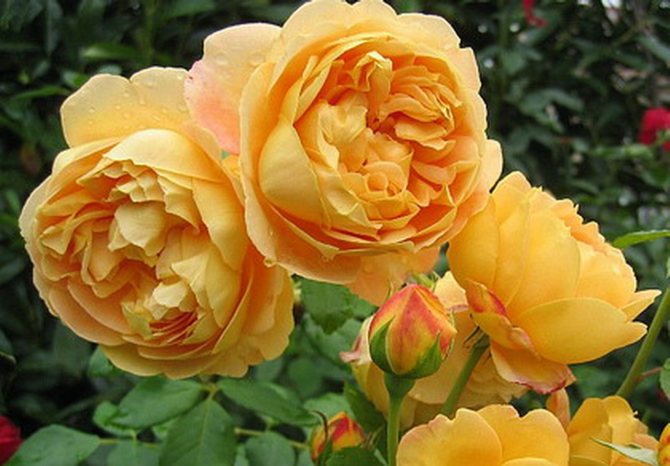

Golden Celebration
Description of the variety
Peony Ito-hybrid Bartzell was formed as a result of crossing a herbaceous and tree-like peony. The plant reaches a height of one meter and is yellow in color, but the middle is reddish. The peony itself is large in size and is capable of reaching 20-30 centimeters when unfolded. Several peonies can grow on a bush, but the older the plant, the more flowers it has. Peony Bartzella strongly rises above the grassy part and it looks very attractive. The peony blooms for a long time, for three or more weeks, sometimes it happens that it can bloom twice.
Ito peony has strong stems, so there is no need to tie it up. The leaves of the hybrid peony have a finely dissected structure and remain beautiful throughout the season. The peony loves the sun, so you need to plant it in a sunny area. The hybrid is resistant to cold weather and feels good in winter. The only thing the plant does not like when water stagnates in the soil. Loves fertilizers such as compost and ash, and will not give up on complex fertilizers. The advantage of the Ito hybrid is that it does not need special care.
The history of breeding yellow peonies
The history of hybridization of peonies and the development of a yellow color in flowers is very fascinating in itself. The incredible shades of pink and milky watercolors of these flowers have won hearts for millennia, but in the 20th century, with the development of landscape design, and the industry as a whole, the desire to get a peony with an unprecedented yellow color quickly grew into an obsession.
The appearance of yellow peonies did not change the popularity of peonies with much more typical shades, but it still became a sensation and added an exclusive, luxurious option to the list of available design options, which is still hunted by both botanical gardens and collectors, and private gardeners - true fans of this amazing plant.
The entire history of breeding yellow colors in herbaceous peonies can be conditionally divided into three periods.
Stage 1 - attempts to achieve a yellow color by crossing herbaceous peonies.
Until 1948, active breeding was carried out around the world, and largely unsuccessful attempts to obtain varieties with a yellow color continued without drastic measures. As a result of selection on the basis of large-leaved peony, Mlokosevich and Vitman, which by nature partially have a yellow flavone pigment, modest varieties with only individual yellow details were obtained.
During this period, the greatest contribution to the hybridization of peonies was made by Earl White, who received the first of the conditionally yellow varieties "Claire de Lune" (Claire de Lune), in which the yellow pigment was so weak that it only gave the flower shades of cream and ivory.
In the same period, other varieties with cream shades of color or yellow color were bred in garden centers around the world only in stamens and staminodes, but not in petals (which are still in considerable demand today "Ballerina" (Ballerina), "White Sands" (White Sands), "Cheddar" (Cheddar Cheese), "A gold bracelet" (Golden Bracelet), "Prairie Moon" (Prairie Moon), etc.).
Stage 2 of Ito-pion selection
The interspecific hybridization of herbaceous and treelike peonies by breeder Toichi Ito was a welcome breakthrough in peony breeding. Crossbreeding peony yellow (Paeonia delavayi), the only peony in which the yellow carotenoid pigment was stable and allowed hybridization without loss of tone, with herbaceous semi-double peony allowed to get the first variety in history with yellow picturesque flowers.
The official year of the "start" of yellow peonies is 1948, the full flowering of plants with a unique color took place after the death of the breeder.Until 1967, when the rights to the hybrids were sold, 4 more yellow varieties of Ito hybrids bloomed, and today they remain stellar.
Stage 3 - Acquisition of Hybrid Rights and the Beginning of American Peony History
The beginning of the history of yellow peonies on the territory of Luis Smirnov's New York peony nursery with the official registration of varieties under the name Ito-Smirnov marked the period of replenishment of the collection of varieties and the beginning of the modern history of yellow peonies.
Registered in 1974, the four basic varieties began to spread around the world, and the definition of "Ito hybrids" became not only a class of peonies registered by the American peony breeder community, but also a protected trademark. Other American breeders also actively worked to expand the palette of yellow or nearly yellow peonies, and for two decades, almost every year, a new name from the Ito hybrids section appeared in the catalogs.
Since the end of the 80s of the last century, the selection of Ito hybrids, like peonies in general, cannot boast of positive dynamics. Almost all varieties on the market were bred a long time ago, and if new items appear, they are far from impressive in number.
Planting and leaving
A distinctive feature of the Bartzella peony is its durability. It can grow in one place for ten or more years, the main thing is that this place is sunny and warm. In order for a flower to grow well, it needs to be provided with fresh soil in which there will be enough nutrients.
Preparing for planting
In order for the Ito peony to take root, it is necessary to choose the right material for planting. There must be 2 kidneys on the parcel, then it can be considered of high quality. The planting material should have 5 buds and the same number of roots. If rot has formed on the roots, then it must be cleaned off and sprinkled with ash. For prevention, it is best to soak the cut in a solution of 5 liters of water and 2 grams of potassium permanganate before planting.
A flower bought in a container must be carefully removed along with the soil in which it is planted, and only then it is planted in open ground.
When planting, it should be borne in mind that the buds should be at a depth of 3-5 cm, if this is not done, then the plant will not delight the grower with beautiful flowers. A hole is dug in advance so that the soil has time to sink. At the bottom, you need to lay out a mixture of equal proportions:
- sand;
- peat;
- garden land.
Also, Ito peony needs primary feeding, consisting of:
- ash in the amount of one can;
- superphosphate - 150 gr;
- iron sulfate - 1 tbsp. the spoon.
When the seedling is already in the hole, and it is time to fill up the soil, you need to make sure that the clod of earth above the plant is not higher than 5 cm, otherwise the peony simply will not bloom. Hybrids do not like large hollows, because in the spring there will be a lot of moisture in them after the snow melts, and in the summer rainwater will collect. Despite the fact that the variety is strong, if the air circulation in the garden is disturbed, it can pick up diseases. Therefore, you should not plant near buildings, other plants and trees.
Care features
Florists say that Bartzella's peony requires simple maintenance. The plant must be well watered, but at the same time make sure that the moisture leaves and does not stagnate. In hot summer, one bush is able to drink 2 buckets of water, and in other seasons it is much less. Watering is necessary when the soil on the surface is completely dry.
Caring for the plant also includes protecting it from weeds. Ito hybrids do not like other plants or weeds growing nearby. And he also needs loose soil, only then will the peony delight with lush bushes and beautiful flowers. In winter, he does not need additional protection in the form of a film, because the plant is considered frost-resistant. But as soon as the snow thaws, you need to immediately remove the top layer of mulch so that its buds begin to germinate.
Further care
Yellow peonies
If the landing was successful, this does not mean that this is all. Regular care is ahead.In principle, Ito-peonies are quite unpretentious. Flowers will delight for a long time if you follow simple rules:
- Moisture balance. Watering should be done sparingly, since a lack of moisture will affect the condition of the flowers, making them lethargic and inconspicuous. But an excess of water will simply lead to rotting of the root system.
- If the grower cannot provide moderate watering, say, during the rainy season, then special means, such as alirin or gamair, should be added to the soil. Their principle of action is based on protecting the roots from decay.
- It is recommended not to overdo it with feeding. As with watering, balance is important here. It is best to use natural products such as dolomite and bone meal, mineral supplements, phosphorus-containing mixtures.
- Plucking the first buds in order to improve further growth or not - the gardener decides on his own. This is due to the fact that breeders have not yet fully traced the connection between this.
- In preparation for freezing, the stems and buds that are responsible for growth should be cut.
- It is not at all necessary to cover Ito-peonies for the winter, since these plants are extremely hardy. Unless very young plants can be insulated with spruce branches.
Hybrid Ito-peonies will be a wonderful decoration for any garden, because they have excellent characteristics and, most importantly, incredible aesthetic properties.
Flower propagation
The Bartzella peony propagates simply - it is enough to divide the bush with a rhizome. The best time to breed is late August or early September. If the flower is transplanted later than this period, it is better to use growth stimulants so that its roots take root better.
The plant should be propagated over two years. It is worth noting that it will be difficult to divide the rhizomes with a knife, because its root system is strong. When dividing, you need to remember that you cannot damage the root system, otherwise the whole plant will die.
Division sequence:
- The bush is dug out of the ground, but before that it needs to be well watered. Remove excess soil from the roots;
- With a sharp knife, divide the roots into two or three parts, taking into account the number of buds;
- When the separation has been successful, sprinkle all the cut areas with charcoal and put to dry in a dark place;
- Then the bushes can be safely planted in the ground.
Ito peony looks original in any decorative composition. They can be planted as an independent plant, and they will look beautiful in large flower beds. Another advantage of the hybrid is that it can be stored for a long time in cut form.
A stunning bouquet of Ito hybrids can delight anyone for a long time.
Peony Bartzella is considered a beautiful Ito hybrid with a strong aroma and rich color of the flowers themselves. In order for a flower to please the eye all the time, all the subtleties must be taken into account when planting and leaving.
A valuable gift for lovers of luxurious flowers is the Bartzella peony, which combines royal stature, sophistication of color and high winter hardiness. This is the oldest variety, tested by time and by the difficult climatic conditions of the middle zone, including the Moscow region and the Leningrad region.
Reproduction of a peony rose
Most often, this rose is propagated by cuttings. Cuttings can be cut by yourself or bought if there is no mother plant. They are usually cut before winter and kept at home in a cool place, wrapped in damp paper. When callus appears at one end of the cuttings and the buds grow, the cuttings are planted in pots, and in the summer they are transplanted to a suitable place in the garden.
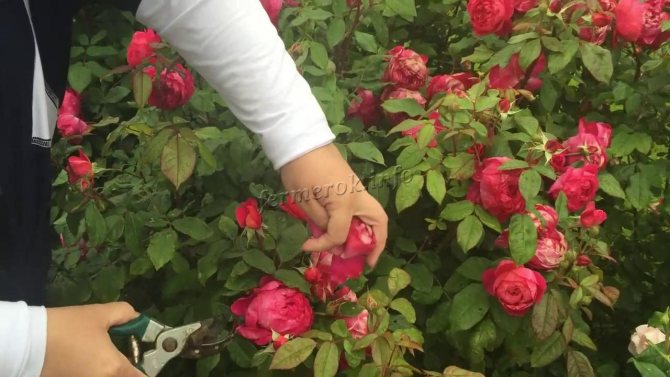

Pruning of peony roses is usually carried out in the spring before the start of sap flow.
If the cuttings were purchased in the spring, they do not need to be kept in the newspaper. One side is simply dipped in a growth stimulator, and then immersed in loose, nutritious soil and covered with a jar or cut plastic bottle on top to create a greenhouse. When the plant grows, you can remove the bottle.
Small, well-developed bushes of this type of roses can be bought online or in garden shops, in the market. They are easy to plant. They grow much faster than cuttings and delight with their flowering in the shortest possible time.
Very often, such roses are grafted. The stock can be a loose rosehip, or a steppe rose, as it is popularly called. In summer, budding is usually carried out on a T-shaped stock. The kidney is carefully fixed in the bark incision and wrapped around so as not to shift. From the sun and rain, as well as strong winds, it is best to come up with some kind of protection. And it will be possible to remove it only when a new pagon begins to grow from the bud.
Botanical description of peony Bartzell
The cultivar Bartzella (or Bartzella) is obtained as a result of complex breeding work carried out by the assistant and follower of the Japanese scientist Toichi Ito, who is the founder of a new group of peonies named after him. Ito-peonies are intersectional hybrids created with the participation of lactic-flowered and tree-like varieties. Bartzella was introduced into the culture in 1972 and since then its popularity has not waned, despite the fact that nowadays there are already many other yellow-flowered Ito hybrids.
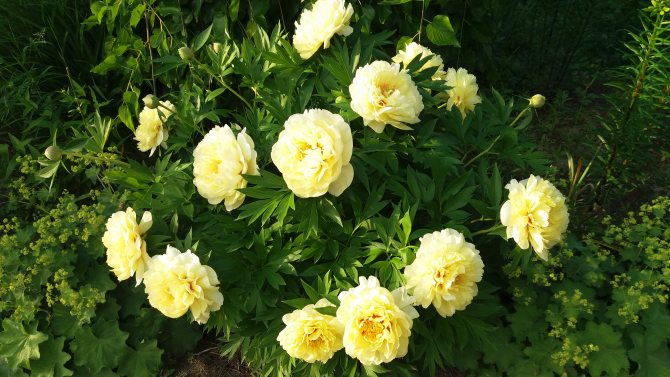

Bartzella peony blooms on annual shoots that emerge from the base of the bush, like herbaceous varieties. But at the same time, it retains the lower lignified part with renewal buds, which can successfully overwinter provided a combination of additional shelter and a relatively mild snowy winter. The height of the bush is up to 90 cm, in harsh conditions (Siberia, the Urals) - no higher than 50 cm.
The leaves of Ito-peonies remain decorative until late autumn, as in tree-like varieties, acquiring a copper-red color. The flower of the Bartzell peony is double, large, pale yellow in color with red or dark pink strokes in the core. The flowering time is from mid-June onwards for almost a month. Bartzella has a delicate, pleasant aroma; without this clarification, the description of the variety would be incomplete.
WHERE TO BUY PIONE SEEDLINGS
The Scientific and Production Association "Sady Rossii" has been introducing the latest achievements in the selection of vegetable, fruit, berry and ornamental crops into the wide practice of amateur gardening for 30 years. In the work of the association, the most modern technologies are used, a unique laboratory for microclonal plant propagation has been created. The main tasks of NPO Sady Rossii is to provide gardeners with high-quality planting material for popular varieties of various garden plants and novelties of world selection. Delivery of planting material (seeds, onions, seedlings) is carried out by Russian post. We are waiting for you for shopping: NGO "Gardens of Russia"
Landing in open ground
A pit measuring 50x50x50 cm, having a drainage layer at the base and filled with a special fertile mixture, is what any Ito hybrid needs. Peonies of this section are demanding for a successfully prepared start.
The usual planting time for peonies is from late August to late September. Later dates are extreme for the conditions of the middle lane.
Small stones, fragments of slate, broken brick, a layer of 10-15 cm are suitable as drainage. A mixture consisting of 3 buckets of humus or high-quality compost, 0.5 buckets of wood ash, 6 tbsp. bone meal and 1 tbsp. any complex mineral fertilizer.
- The filled hole is generously spilled with water and a seedling is placed in the center so that the upper bud is buried 4-7 cm from the soil surface.
- Pour on top again from a watering can to compact the soil.
- When planting in autumn, it is necessary to immediately huddle the peony with dry humus or compost (do not use peat!) In the amount of 1 bucket.
- In the spring, after thawing the soil, this land must be carefully raked off.
Planting AID peonies
To ensure a proper landing, you first need to choose a place. Should not be planted:
- Ito-peonies next to the roots of trees or shrubs.This is due to the fact that the flowers will lack moisture and nutrients.
- Near residential buildings, because water coming off the roof can damage them.
- In low places where a lot of moisture often accumulates. As a result, rotting of seedlings may occur.
- In the shade, but direct exposure to sunlight is also harmful. It is necessary to find the optimal places of partial shade, due to which the flowering time will increase.
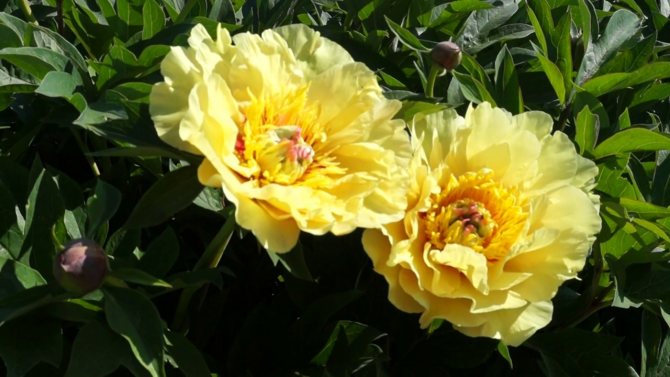

Itoh-hybrid
Peonies - all about them
The best time to plant is late August or early September. It is possible later, the main thing is that the soil is not frozen.
It is advisable to prepare a pit for planting in advance so that the earth has time to compact a little. To allocate flowers is a fairly large area than for ordinary peonies. This is due to the fact that ito-hybrids grow strongly.
Important! If the depth of the planting pit for the usual one needs 60 cm, then the size of the Ito-pions should be at least 90 by 90 cm.
The soil
The prepared flower bed must be filled with soil containing the required amount of nutrients. Ideal for Ito-pions are neutral and slightly alkaline soils. The soil should consist of:
- humus and manure;
- dolomite flour, the concentration of which is chosen depending on the type of soil (clay, sandy or loamy) in the amount of 150-500 g. It is needed to deoxidize the soil;
- wood ash (200-500 g);
- bone meal (200-400 g);
- double superphosphate (200-400 g).


The prepared flower bed must be filled with soil.
These substances are mixed with ordinary soil from the garden. The resulting mixture is laid out in a prepared pit.
In addition, growth accelerators, mineral fertilizers and parasite prophylaxis can be used.
Diseases, pests and methods of dealing with them
Despite the fact that peonies are considered resistant to diseases and pests, plants, and sometimes difficult times come for them.
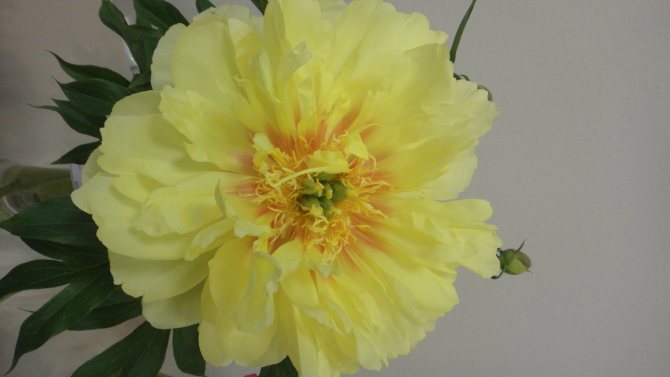

- Rust. The numerous spots-pads of brown or copper color that have appeared on the leaves are a sign that spores of the rust fungus have appeared on the flower. The diseased leaves are cut off and burned, and the bushes are sprayed with a solution of any copper-containing preparation.
- Powdery mildew. Whitish spots on the leaves do not bring much harm to the plant, but clearly reduce their decorative qualities. To combat their spread, you can use a 0.5% solution of soda ash with the addition of green or laundry soap. It is necessary to carry out at least 2 treatments with an interval of 7 - 10 days.
- Gray rot. A dangerous disease that spreads especially quickly in cool, rainy summers. The first sign of the disease is the wilting of young peony shoots in spring, then a gray bloom (mold) appears, affecting the entire aerial part of the plant. On diseased bushes, the affected areas are cut out and spilled with 0.6% Tiram suspension. As a preventive measure, spring treatment with copper-containing preparations is used.
- Verticillary wilting. A dangerous disease that usually leads to the death of the plant. It is manifested by wilting of leaves and stems on an outwardly healthy peony. Since the causative agent of the disease penetrates inside, into the vascular system of the plant, the fight against it is not possible, therefore, the affected bushes are dug up with the maximum possible lump of earth and destroyed outside the site. The remaining pit is treated with bleach.
Most often, you can see aphids, ants and bronzes on peonies. All of them harm, mainly, unopened buds and inflorescences in full dissolution. You will have to get rid of ants with the help of repellents scattered under the bushes, and to combat aphids and bronzes you need to use insecticides - Actellik, Biotlin, Aktaru, Inta-Vir and others.
Sometimes the root system of peonies is affected by colonies of rootworm nematodes, whose presence can be detected by the sight of swollen nodes on the rhizomes. Unfortunately, diseased bushes will have to be removed from the site in order to prevent further spread of the pest.
Austin hybrids red
Peony tulips
Red is a symbol of love and passion. Red buds of peony roses in themselves attract attention, excite and delight. That is why flowers of this particular shade are most often chosen as a gift for the second half.
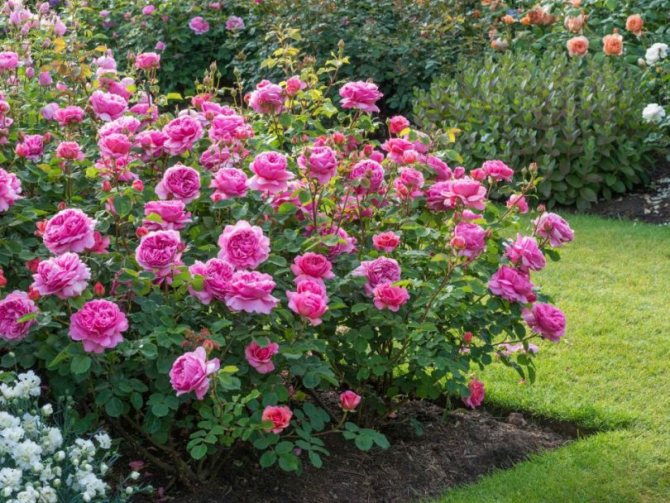

Austin hybrids red
Shakespeare (William Shakespeare)
Shakespeare is a massive shrub, reaching 2 m in height and 1.2 m in width. The variety is resistant to pests, harsh climatic conditions and many infections. Shakespeare rose blooms 2 times a year - in early summer and autumn.
The flowers of the variety are large, double. They form inflorescences consisting of 3-5 buds, the average diameter of which is 8 cm. The color of the petals is varied and varies from scarlet to purple shades.
The aroma of Shakespeare rose is strong, intense.
William Shakespeare 2000
Shakespeare 2000 is a vigorous, unpretentious variety with the scent of old roses. Hybrid bushes grow up to 1.8 m in height.
The flowers of the rose are of a bright red or even crimson hue, densely double, with a rich aroma, in which violet notes are felt. The buds are located on the shoots singly.
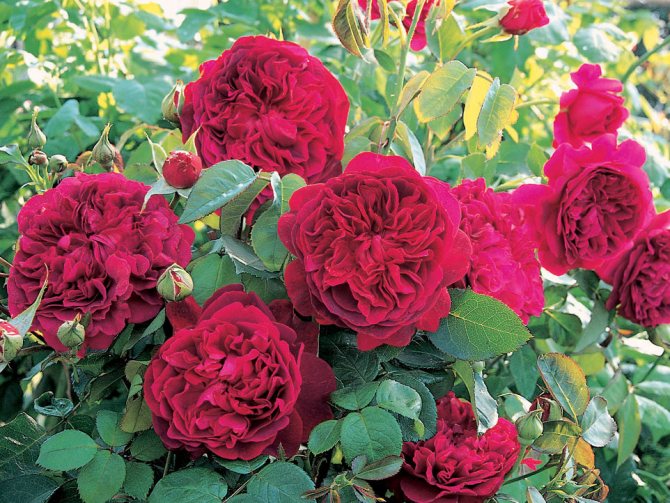

William Shakespeare
The rose is shade tolerant and has excellent disease resistance.
Benjamin Britten
Peony roses of this variety are resistant to low temperatures and many infections. The buds of the Benjamin Britten hybrid reach 12 cm in diameter. Flowers are collected in inflorescences of 3 pcs. and have a light fruity aroma. The color of the petals ranges from crimson to orange.
A distinctive feature of the rose is the nature of flowering - the buds remain closed throughout the entire period.
The height of the bush rarely exceeds 1 m.
Benjamin Britten
Munstead Wood
The Munstead Wood peony roses have a very rich and sweet scent. Their burgundy petals have a velvety texture, and as they open, the color changes to a darker one.
Rosebuds form inflorescences with an average of 6 flowers.
The height of the bush is 1 m, the diameter is 50-60 cm.
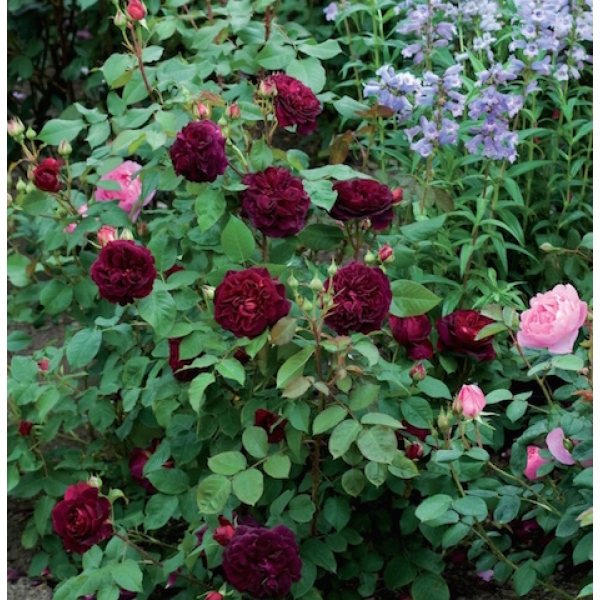

Munstead Wood
The rose blooms profusely and for a long time. The variety is resistant to sudden changes in weather conditions and various diseases.
Peony Bartzella in landscape design
To emphasize the beauty and grace of the noble Ito-peony Bartzell in the landscape design of a country garden, you will need to observe several basic rules:
- You need to choose a place very carefully, given the fact that peonies can grow in one area for many years in a row, becoming only more beautiful and stronger.
- An adult Bartzella peony looks spectacular on the lawn, being planted as a tapeworm in a single copy or in a group.
- The flowering period of Ito hybrids is about a month, but after that, the decorative foliage serves as an excellent background for flowering partners in the flower bed.
- Ideal companions for the yellow peony Bartzell during the period of greatest decorativeness are blue, blue and purple flowers - delphiniums, veronica, aquilegia, geraniums, bells. Since the middle of summer, another royal personage, the rose, takes over the torch of abundant flowering from the peony. These two plants are very often planted in the neighborhood when drawing up a landscape plan for a site.
The amazingly harmonious culture of the Bartzell peony does not leave indifferent anyone who has ever admired its flowering. Yellow Ito hybrids will remain an object of admiration and an object of desire for true connoisseurs of beauty for a long time.
Pink hybrids
The most common color for peonies is pink. And Austin roses of the same pink color further emphasize the similarity of these roses to peonies. At the same time, the color saturation depends on the variety, and varies from pale pink, almost peach, to fuchsia. These roses have a large double flower with dense rounded petals. The most famous, one might say, classic varieties of such roses are:
Constance SPRY
Climbing rose of a pale pink shade was bred in England in the 60s of the last century. Its flowers reach 15 cm in diameter, having 5-6 pieces in inflorescences. They bloom from early June to late July and have a very pleasant aroma. The height of this rose can be over 5 m, the bush is strong. strong and spreading. Very spiny small thorns on thick stems. For such a rose, you definitely need a support. By the way, such a rose feels great in a shaded place.
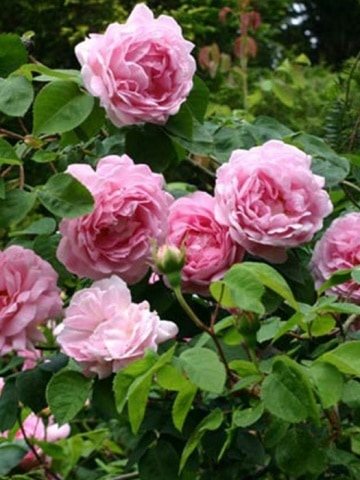

Miranda (MIRANDA)
In 2005, another peony rose variety was bred in England, very reminiscent of Constance Spry. Miranda's flowers are somewhat smaller, about 12 cm in diameter, and have an interesting color that ranges from white to bright pink. The inner petals of the flower are the most brightly colored. The aroma of this rose, although pleasant, is poorly expressed. Such a bush rose blooms twice a summer, and the second bloom lasts almost until the end of October. Flowers are solitary, do not constitute inflorescences. The bushes are compact enough, you can grow these roses without support.
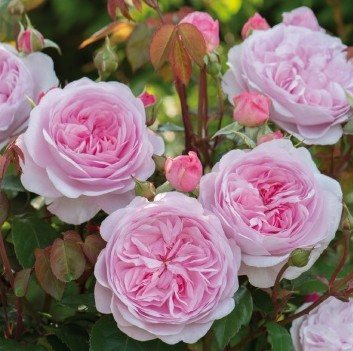

Rosalind (ROZALINDA)
This is another famous peony-like rose variety. Rosalind has rather large single cream-colored flowers that reach a diameter of 12-14 cm. The rose has a very pleasant delicate aroma.
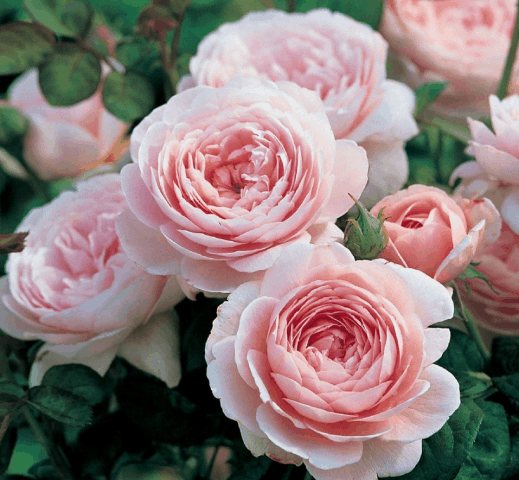

Care rules
After planting, it may happen that in the first year the bush looks lethargic. However, you should not worry about this, since its recovery takes a long time. In addition, in the first year, peonies do not bloom, but only in the second, and sometimes in the third year. However, there are varieties that continue to bloom even after transplanting.
In addition, one must remember that this plant does not like transplants at all. Therefore, this should not be done without special need.
It is best to replant the plant in the fall, and not in the spring, so that it can recover during the autumn-winter period.
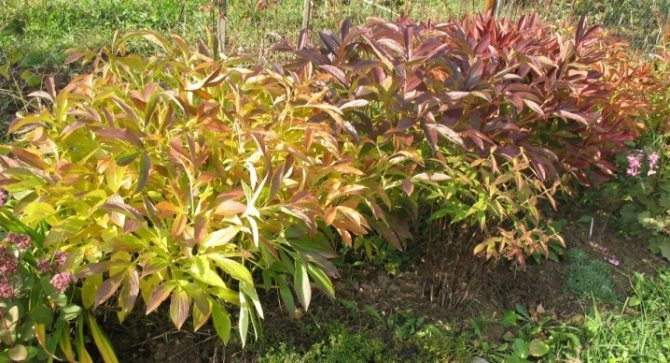

These plants do not require special care.... Since most of them are frost-resistant, there is no need to cover them for the winter period. This should be done only in cases where young seedlings were planted. Then they can be covered with moss or fallen leaves.
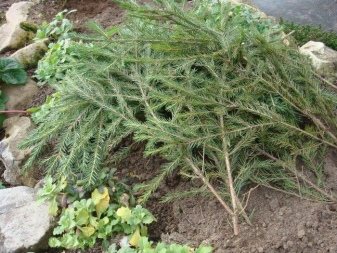

In addition, in the spring, they need regular watering. And also it is necessary to carry out weeding and timely feeding. In this case, it is necessary to fertilize in the early years by foliar method. It will be enough to do this 3 times per season. The first time in the spring, the second - before flowering and the third - at the end of August. In the fall, all stems must be cut off.
Austin white hybrids
Hybrid tea roses
White peony roses are not as common as yellow, red or pink cousins. This is because pure white is almost impossible to breed when breeding roses. As a result, in most cases, the flowers of plants have a weakly expressed additional shade: peach, pink, cream or yellowish.
Tranquility
Tranquility is a powerful shrub, the height of which reaches 120 cm. The variety is distinguished by the almost complete absence of thorns.
The flowers of the rose are medium in size, their diameter ranges from 10 to 12 cm. The closed buds are yellowish in color, but the petals of the opened flowers are painted in a lighter color. The scent of Tranquility rose is reminiscent of the scent of apples.
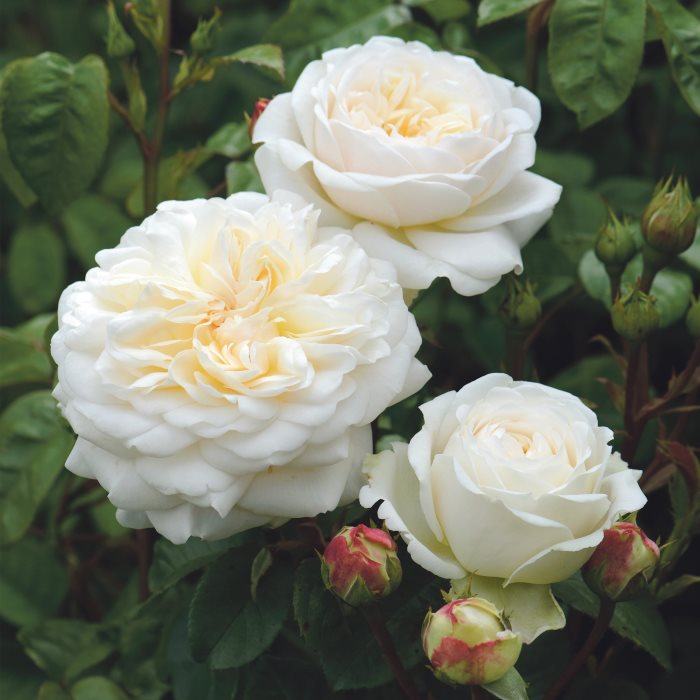

Tranquillity
The hybrid blooms 2 times a year.
Claire Austin
The buds of this peony rose are in the form of small cups with a diameter of 8-10 cm. They are formed into inflorescences of 2-3 buds, due to which the shrub has a rather lush appearance. Claire Astin's flower petals are creamy white.
The height of the bush rarely reaches 150 cm, but the width is on average 100 cm, since the variety is rather sprawling. It tolerates high humidity well and blooms twice a year.
Claire Astin's scent is intense.
Alabaster
Alabaster is a white peony rose with large double buds forming inflorescences of 4-6 flowers.Rose bushes grow up to 1 m in height and 50 cm in length. The stems of the plant are long, tough, so the flowers of the variety are convenient to use when making bouquets.
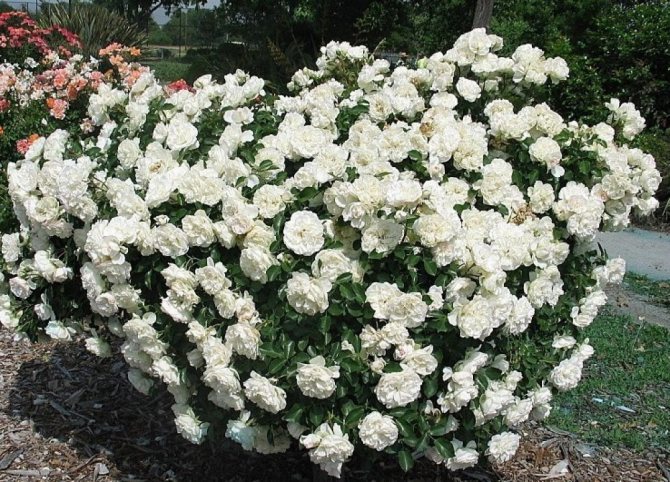

Alabaster
The Alabaster rose blooms twice a season.
What to remember
- Features. Ito hybrids were obtained by selection of herbaceous and tree-like peonies, a distinctive feature of which is a bright spot at the base of the flower petals.
- Varietal qualities. Depending on the variety, some are dominated by tree-like or herbal features. Therefore, they are more or less adapted to the harsh climatic conditions.
- Decorative properties... Ito hybrids have beautiful carved foliage densely covering the stems and large double and semi-double flowers with a pleasant aroma.
Shelter for the winter
In areas with a cold climate, you need to cover roses for the winter. For this, you can use dry leaves, straw or sawdust.
Important! In no case should the bushes be covered with a film, as this will limit the supply of oxygen to the plant and lead to its death.
Peony roses are distinguished by a high degree of decorativeness, which is achieved due to the cupped buds and the compact shape of the bush. In addition, the undeniable advantages of Austin roses include the richness of the color palette, resistance to many diseases, ease of care, and rapid growth. The only pronounced drawback of these plants is the weak frost resistance of many varieties. However, this is a small price to pay for the pronounced heady scent and delightful appearance of peony roses.
Now, having learned about the various varieties of peony roses, it will be easier for a florist to choose one or another type. White, pink, red queens of the garden will decorate any site. The main thing is to choose a variety suitable for the region and carry out the correct planting and care!
Peony care in autumn
In spring and summer, peonies do not need special attention. During the season, they only need timely weeding and watering. Since the flowering of peonies is lush and long-lasting, and the bush is voluminous, by autumn the roots of the plants lose a lot of nutrients and weaken. Therefore, in the fall, peonies need care, which consists in pruning, feeding, protecting plants from pests and diseases, and of course preparing for winter.
Pruning
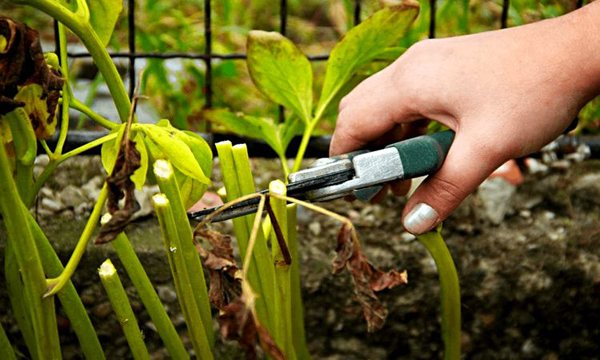

The first pruning of peonies is carried out after the end of their flowering. When pruning, use alcohol-disinfected, sharpened garden shears, pruning shears or a knife.
When pruning, wilted flowers are removed. Leaves and stems should not be touched at the same time. Early pruning of the aerial part of the peonies, instead of beneficial, brings harm to the plants. Flowers after active growth and abundant flowering are weakened and need good nutrition, and photosynthesis in the leaves contributes to the nutrition of the root system.
Withered stems of peonies in spring are difficult to prune and at the same time there is a possibility of damage to delicate buds, so they are pruned in the fall, 2 weeks before, or during the first frost.
There are no particular difficulties in pruning in the fall. Bushes are trimmed when the leaves take on a reddish tint and lie on the ground.
Previously, peonies are also not worth pruning, early pruning negatively affects the flowering of peonies next year.
Tree varieties peonies are cut on the arrival of the first frost. They have the following types of pruning: shaping and anti-aging. In the first case, pruning is carried out to give the bushes a beautiful shape. In autumn, all lignified stems are cut by 0.7-0.9 meters. At the same time, diseased, dry, damaged shoots and all leaves are also cut out.
The next year, a large number of young shoots and flowers are formed on the bushes. Cut bushes are easier to hide for the winter.
Rejuvenating pruning of peonies in the fall is done every 10-15 years. This removes old shoots to activate the growth of new stems.The need for a procedure is determined when the bushes begin to grow worse throughout the season, and flowering decreases or stops completely. With rejuvenating pruning, the life of a perennial can be extended to 60-80 years.
Herbaceous varieties of peonies cut off 2 weeks before the first frost. In this case, the stems and leaves are cut out completely (to ground level) or stumps with a length of 2-3 centimeters remain.
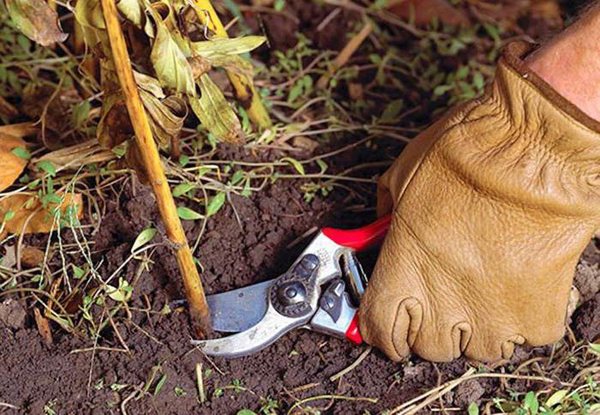

Ito hybrids tolerate frost well, their pruning is carried out at the same time as in tree varieties. When pruning, all sprouts of Ito hybrids are removed to the root or 2-3 centimeters above the ground remain. These plants form buds in the fall that protrude slightly above the ground, so you need to be careful when pruning.
At the end of the pruning of any types of peonies, all leaves and stems, as well as the debris accumulated under the plants, are removed from the site and burned.
If the autumn at the time of pruning is warm and dry, at the end of the work the flowers are watered with water, but not much, since excess moisture prevents the plants from preparing for the dormant period.
Top dressing
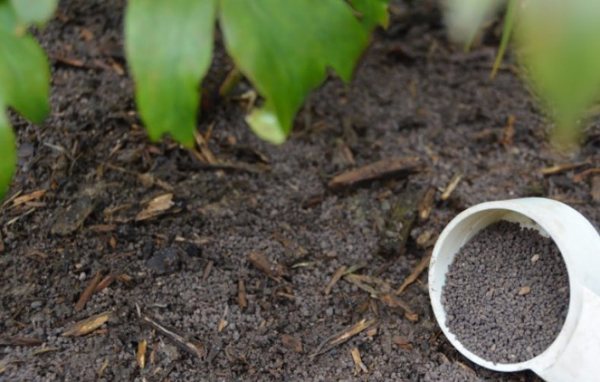

Top dressing of peonies in the autumn period is necessary for their lush flowering next year. When feeding, the roots accumulate useful substances and in the spring, with the growth of the aerial part of the plant, they give all the accumulated vitamins to the bush and buds.
Plants are fertilized 1 month before the arrival of the first frost. When feeding, potash-phosphorus or complex fertilizers are used.
Fertilizers containing nitrogen are not used! You can feed peonies in 2 ways: liquid and dry.
Liquid feeding of peonies is used if the autumn is dry and the ground under the bushes is dry. For feeding, fertilizers are used in the form of tablets. One bucket takes 1 tablet of phosphorus and 1 tablet of potassium. The tablets dissolve in water. The resulting solution is watered with peonies at the rate of 1 liter of liquid per bush. If the bushes are large, then the dosage is doubled.
Dry peonies are fertilized in rainy weather. A liquid method of feeding peonies, with frequent precipitation is not used. For the dry method, granules are taken (15 grams of potassium and 20 grams of phosphorus per bush). Such dressings work longer than their liquid counterparts. At the same time, plants receive dosed nutrients.
An incomplete handful of granules is evenly scattered around the bush. For a longer dissolution, they are embedded in the ground when loosening the soil.
After pruning, each peony bush is fertilized with a mixture of 300 grams of wood ash and 200 grams of bone meal.
How to feed peonies in autumn, pruning peonies: video
Treatment against diseases and pests
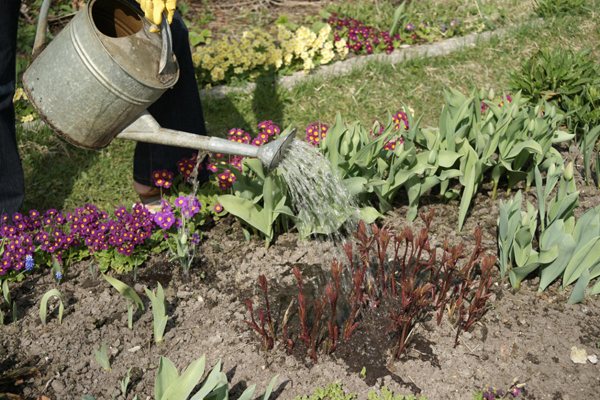

Viruses among peonies spread very quickly, affecting a large number of plants. They are transmitted by pests and when pruning flowers with dirty, untreated tools.
Withered leaves and stems of peonies are an excellent place for the accumulation and reproduction of pests, diseases, so they must be removed in a timely manner. After trimming, they need to be taken out of the site and burned.
Weakened plants are affected not only by viruses, but also by fungi. Terry varieties of peonies of American selection are especially susceptible to damage.
Only transplanted peony bushes also belong to a special risk group. In a new place, the flowers go through a period of adaptation, and their immunity decreases. Prevents infestation of flowers by treating them with fungicides or potassium permanganate.
Read also: Compositae root system
Preventive treatment of bushes from diseases and pests helps to prevent the appearance of diseases. The procedure is carried out before planting peonies. The plant is dipped in a solution of copper sulfate, Maxim, Fitosporin-M for half an hour.
Already growing plants are sprayed with one of the above drugs, and the soil is spilled with a solution of Bordeaux liquid.
Removing shoots in the fall, deoxidizing the soil with ash, dolomite flour or lime, moderate watering and planting flowers at a distance of 1 meter from each other allows you to maximally protect plants from diseases and pests.
Insects rarely have a significant effect on peonies, but worsen their decorative appearance and spread diseases.
To protect against pests, the bushes are treated with Iskra, Fufanol, Karbofos, Aktellik.
To prevent harmful insects and diseases from accumulating in the soil, the soil around the bush is dug up before winter.
Growing features
There is no big difference in the cultivation of Ito-varieties or ordinary peonies - the agricultural technology of their cultivation in the regions of central Russia is the same. The only difference is that the former are more exacting to the acidity of the soil than in herbaceous ones. In advance, if necessary, add ash after burning wood residues or dolomite flour to it.
Agrotechnical conditions
The best place for planting Ito-pions is sufficiently illuminated, with loose soil, rich in humus, neutral, can be slightly alkaline (pH - from 6.5 to 7.5).
Places where these plants should not be planted:
- next to trees, shrubs with a large-scale root zone. Plantations will have to fight for nutrients;
- near buildings, if the bushes fall under the runoff of water from the roof;
- in lowlands, where melted spring waters accumulate or after rain.
Ito varieties tolerate partial shade well. The best option is when there is a possibility of shading them in the midday heat. Such conditions can significantly extend the flowering period, preserve the aroma and brightness of the petals.
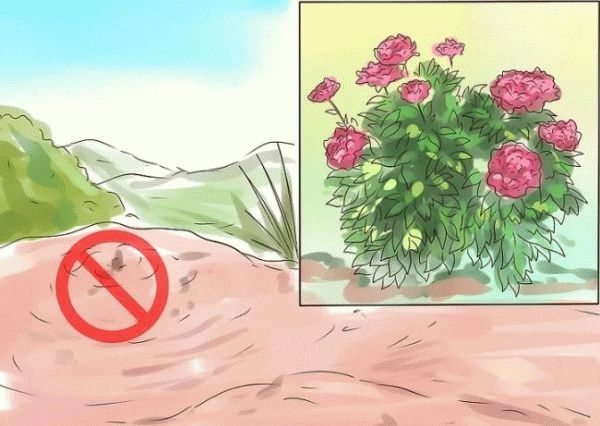

Landing dates
The optimal planting period for Ito-pions is the very end of August plus the entire first autumn month. In regions with a warm climate, this period can be extended until the end of October. At this time, the plants manage to get into the non-frozen soil, take root before the arrival of stable frosts. Regardless of when the hybrids are purchased, they are only planted in the fall.
Landing technology
Before planting the plant, the pit intended for it must settle, be compacted, so it is better to prepare it in advance. Ito hybrids grow in depth and in breadth, so the pits are prepared in size: 60-90 cm in depth, 85-110 cm in width.
For any soil, a handful of mineral complex fertilizers will not be superfluous. Mix, if necessary, ash or dolomite flour with garden soil, and two-thirds of this composition is filled in the recess for planting.
The division should have 2-5 roots and the same number of renewal buds. Treatment with a growth stimulant ("Epin", "Zircon" or others) will be useful, especially if planting is carried out later than September. If the cut is purchased long before the planting date, it is stored by placing it in sphagnum or slightly moistened peat, in a plastic bag in the vegetable refrigerator section.
Pruning bushes
Buds appearing in the first two years should be removed immediately. Such early flowers, as already mentioned, will not be beautiful. But they are quite capable of weakening the bush and slowing down its development.
For mature plants, pruning is done in mid-June. At this time, all dry inflorescences are simply removed. When pruning, it is also important to remove any leaves and petals that have fallen to the ground. This is done to reduce the risk of developing fungal diseases. Actually, the very pruning of old flowers contributes to the establishment of new reproduction buds. The more they are formed, the more magnificent and more beautiful the peonies will be for the next year.
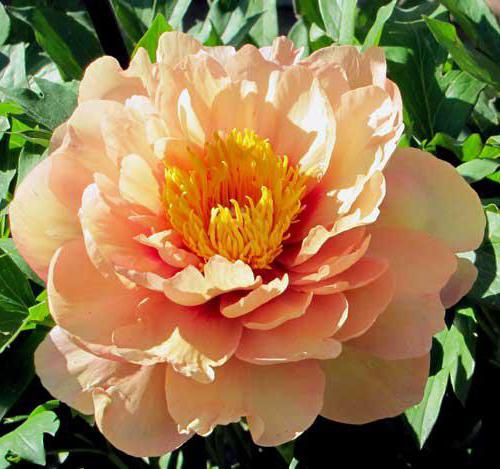

Sergei Kovalenko
Sergey Kovalenko Russia, Moscow region, Fryazino 02/10/2015 07:25
Even in the recent past, beautiful and bright peonies were generally a rare exotic in our gardens. I'm not even talking about yellow, lilac, coral or bronze-pink colors with different shades of the same yellow in ITO-peonies, which appeared only in the second half of the last century and have not yet gained due popularity in mass amateur gardening. There are several reasons for this - this is still the relative high cost of ITO hybrids, especially the newest and rare varieties, and their still absence on the wide consumer market, as well as available and objective information about them in various mass media.
I will make a reservation right away that this article does not at all pretend to be any novelty or special exclusivity of the information presented in it. All the facts stated in it have long been known to well-informed amateurs and, even more so, to all specialists in this field. My goal is only to further popularize these wonderful and very beautiful plants, an attempt to once again give a brief and accessible information about the appearance of ITO hybrids, as well as about their similarities and differences with ordinary herbaceous and tree-like peonies. In addition, I would also like to offer my readers some of the most concise and accessible information on the agricultural technology of their cultivation. No more. You can always find more extensive and in-depth information on this topic both on the Internet and in the list of already published articles of this Internet portal, respected by me.
Now let's figure it out in order. Admirers of herbaceous peonies all over the world have long dreamed not only to enhance the brightness and color of herbaceous peonies, but also to create truly bright yellow varieties with a stable yellow color. And if you're lucky, then use other bright colors or other useful properties that were not yet characteristic of herbaceous peonies.
One of the many who tried to solve this problem was the Japanese breeder Toichi Ito. He crossed the yellow-flowered treelike peony `Alice Harding 'with the white semi-double herbaceous peony` Kakoden'. After lengthy experiments, he nevertheless succeeded in 1954 to obtain the desired seeds of the so-called intersectional hybrids with excellent semi-double or double yellow flowers. But, unfortunately, the Japanese breeder, after whom this new group of peonies is named, was never able to see the triumph of his long-term efforts - his first hybrids bloomed only in 1964, already 8 years after his death. Its first varieties are now widely known as ‘Yellow Crown’, ‘Yellow Dream’, ‘Yellow Emperor’, ‘Yellow Gem’ and ‘Yellow Heaven’.
Unfortunately, the first AID hybrids had a significant drawback - most of their flowers were hidden inside the foliage and bush. This annoying shortcoming was successfully eliminated by his numerous followers. And now a large number of beautiful spreading varieties with various bright colors of large, mostly simple and semi-double flowers, which bloom on long and strong peduncles, have already appeared. Of course, there are also terry varieties, but they are still in the minority.
Further breeding work to obtain new intersectional hybrids of peonies consisted of crossing different types of tree peonies on the paternal side, for example, Paeonia suffruticosa, Paeonia lutea or Paeonia delavayi, and on the maternal side - herbaceous lacto-flowered peony (Paeonia lactiflora). As a result of crossing, hybrid plants are obtained that have absorbed the best qualities from their progenitors. What positive qualities did Ito hybrids inherit from their parents? Let's list them:
- Ito hybrids are very resistant to various diseases;
- Adult plants are very winter-hardy and do not need to be covered for the winter. Sometimes only minor cover or mulching of freshly planted young plants is required.
- The flowering period of Ito hybrids is usually longer than that of herbaceous peonies - it often reaches more than two weeks. Usually, flowers first open on the stems in the center of the bush, and then flowering gradually moves into the depths of the plant and to its periphery.
- Flowers of ITO hybrids and their buds often resemble flowers and buds of treelike peonies in shape, with a sharp or pointed top of the buds and often have darker and contrasting spots in the center of the flower.
- The leaves and stems also strongly resemble tree peonies in shape and structure, and the appearance of the bush is like herbaceous peonies.Yes, and they behave quite like ordinary grassy peonies, but they almost always differ in fast and powerful growth and usually do not require a garter. In the winter, their ground part dies off, and in the spring, young shoots appear from the ground again. The height of intersectional hybrids usually does not exceed 1 m. Their lush bushes are so harmonious that even without flowers they always attract everyone's attention throughout the season and even in late autumn, when the foliage of ordinary herbaceous peonies has long since turned black or withered.
- ITO hybrids have retained an important feature from their herbaceous ancestors - the ability to reproduce by dividing the rhizome. At the same time, the roots of ITO hybrids are longer and are located mainly horizontally. Therefore, when transplanting and dividing a bush, it is necessary to dig in the bush itself at a sufficient distance from its center.
The conditional disadvantages of ITO hybrids include non-double or semi-double flowers in most varieties and sometimes their location inside the bush, that is, under the gorgeous spreading foliage. But many amateurs do not pay attention to this at all. In addition, sometimes in unfavorable years, some varieties exhibit variability in the color of flowers, which usually manifests itself in different colors of some of the petals or strokes on the same petals.
At the moment, the list of varieties of ITO-hybrids that have won the well-deserved love of all flower growers has expanded significantly. Now it includes not only varieties with yellow flowers, but also many varieties with white, pink, lilac, bronze and even dark red flowers. I will not specifically list all the varieties I know and love, but I will give only a part of my photos, by which you yourself will be able to judge their true beauty and will be able to form your own individual opinion on this matter.
Now let's discuss a little the agricultural technique of planting and growing AID peonies.
Let's make a reservation right away that there is no particular fundamental difference in growing herbaceous and these peonies. The preparation and filling of the planting holes, the planting itself and the subsequent care are practically no different from the traditional agricultural technology for herbaceous peonies. The only thing, if necessary, you need to take care of the deoxidation of the soil with lime, dolomite flour or wood ash in advance. ITO hybrids are believed to be slightly more sensitive to soil acidity than common herbaceous peonies.
The planting site also does not differ significantly from herbaceous peonies. It is well known that peonies should not be planted in often flooded lowlands, in highly shaded areas, and, if possible, planting should be avoided in the immediate vicinity of large trees and close to large buildings, as well as in areas where peonies can fall under the abundant runoff of water. from the roof. At the same time, ITO hybrids will thrive and bloom well in a small or sliding penumbra, and placing them in places shaded from the midday sun, on the contrary, will make them more lush and allow them to slightly extend their flowering.
The most suitable time for planting in the middle lane in the spring is the end of April, the beginning of May, and in the fall - from the end of August to the end of September. The main thing when planting is that the soil is not frozen and the peonies have time to take root before the onset of stable autumn frosts. It is clear that in more southern regions, these works can be carried out at an earlier or later date, but it is also advisable to plant peonies in an already or still relatively warm ground.
As with all large plants, it is advisable to prepare the planting hole in advance so that the soil in it has time to settle before planting your peonies. For ITO hybrids, the size of the holes should be slightly larger than for herbaceous peonies, since their root system is slightly larger and is located mainly horizontally. In addition, AID peonies have the characteristic feature of expanding slightly in breadth.I usually dig holes 50-60 cm deep and 60-80 cm wide, depending on the space available.
The prepared planting hole is filled with nutritious soil, preferably enriched with well-rotted manure or compost, if necessary, slightly deoxidizing the soil to a pH of 6.5-7.0 using dolomite flour or wood ash. In the spring, you can add a small handful of complex spring mineral fertilizer with microelements to the hole. But just a little, so as not to overdo it. To improve the structure, I add about a fifth of coarse sand to clay soils, and on peat or sandy soils, on the contrary, you need to add about the same or slightly more clay or clay soil.
A pion of ITO peony should have from 2-3 to 5-6 buds of renewal, and preferably the same number of roots, although this is not always possible with roots. If suddenly the cut has rotted a little somewhere during its storage, then this place must be cleaned or cut out with a sharp knife and within an hour process the whole cut in a dark solution of potassium permanganate or, according to the instructions, in a solution of a special preparation "Maxim", which has a bright red color. The use of any proven growth or root stimulants will also be helpful. Small cuts or punctate damage can also be treated with regular brilliant green.
If the division of the ITO-hybrid was purchased at the end of winter or early spring, then it is better to plant it in temporary plastic pots or containers and put it in a bright place, but store it in a relatively cool room with low positive temperatures until disembarking to a permanent place.
When planting any peonies, including AID hybrids, we place the cut in the center of the pit, trying to keep the buds no deeper than 3 - 5 cm from the soil level. Otherwise, the peony may simply not bloom for a long time. This is one of the most common mistakes when planting peonies - excessive deepening of the buds. Moreover, even if the buds on the roots are located asymmetrically and during planting they will not be at the same level, this will not prevent them from germinating in the spring and in the future to form a good bush.
If it was not possible to prepare the planting hole in advance, then when planting, the delenka should be deepened so that the buds are 1-2 cm above the soil level. When the earth settles over time, the growth buds will already be buried correctly. At the same time, it is better to mulch the top layer of the soil to preserve its moisture and further good air exchange. In the first year, your division can give from one to two or three shoots and the first buds that the plant laid before dividing the bush may already appear on them. In this case, the buds must be removed (pinched) even at the stage of their development, since flowering in the first two years will greatly weaken your plant.
All peonies prefer rare but abundant watering. They are very responsive to subcortexes, but they need to be brought in from the second year of life. In the spring and in the first half of summer, plants need fertilizers containing more nitrogen and phosphorus, and after flowering, we apply fertilizers containing the main components in approximately equal proportions or with a slight advantage of phosphorus and potassium. It is also advisable to periodically sprinkle the soil around the bushes with wood ash or periodically water the plants with an ash solution (about 1 glass of ash per bucket of water).
In late autumn, at the very end of the growing season, when the foliage of ordinary herbaceous peonies has already turned yellow, blackened, or simply falls, it must be carefully cut off almost at the very ground. At this time, the foliage of ITO hybrids can retain their decorative effect and vitality for another week or two. And only severe enough cold or frost already at the end of October - in the first half of November, usually leads to the withering away of the leaves of the ITO peonies. At this point, preferably in relatively dry weather, prune our plants. At the same time, I do not always cut off all the stems of the AID peonies to the soil level.Sometimes I leave from 2 to 5 well-developed shoots with 2-3 large buds about 15-20 cm high and cover them with a small box, which, in turn, I wrap with 2-3 layers of white non-woven material of medium density. Thus, I provide these shoots with a relatively dry wintering and in the presence of a decent snow cover throughout the winter, these shoots usually winter well in the Moscow region and, as a rule, bloom well the next year.
About the same I cover my tree peonies, only I use higher and larger boxes or large plastic containers. Well, I can wind the layers of white non-woven material 1-2 more layers. By and large, all these shelters protect last year's shoots only from burns and the scorching sun on fine winter-spring days, as well as from strong frosty and drying winds during relatively inclement periods of winter. And in snowless winters, such a shelter practically cannot protect shoots from complete or partial freezing. This type of shelter works well only in relatively snowy winters, when a small snowdrift forms around your peony. It is clear that all these shelters must be removed in time around the end of March or at the very beginning of April, when the snow has almost melted and the sun has begun to warm up well. At the same time, you can apply a little "spring" complex fertilizer and a little ash directly on the snow. And once again I draw your attention to the fact that I use only white non-woven material, which can reflect strong sunlight on fine early spring days and protect your plants from possible burns.
Some gardeners cut off all the shoots of AIT peonies to the soil level, even if they have to remove some of the healthy buds, which are located on the stems in AIT hybrids, as well as in tree peonies. Yes, you can do that too, if you don't want to mess with boxes and other containers and take shelter of your AID hybrids for the winter. Do not worry, renewal buds have necessarily formed both on the root collar and on the roots themselves, and they may well ensure the further development and flowering of your peony in the next season. Only in this case flowering usually occurs about a week and a half later. But it also strongly depends on the location of your peony, in the sun or in deep partial shade. In partial shade, peonies usually bloom a little later and longer.
The division of the bushes can be done already from the 5th or 6th year of their planting. But the output of the parcels is usually small at this age - on average, from 2 to 5 pieces. And the division process is usually very laborious due to the complete or almost complete lignification of the root collar of the ITO of peonies. But all this, if desired, is completely surmountable, just like any other difficulties. I wish you all the best in this relatively difficult task of growing modern ITO hybrids!
Author of text and photos
Kovalenko Sergey Efimovich
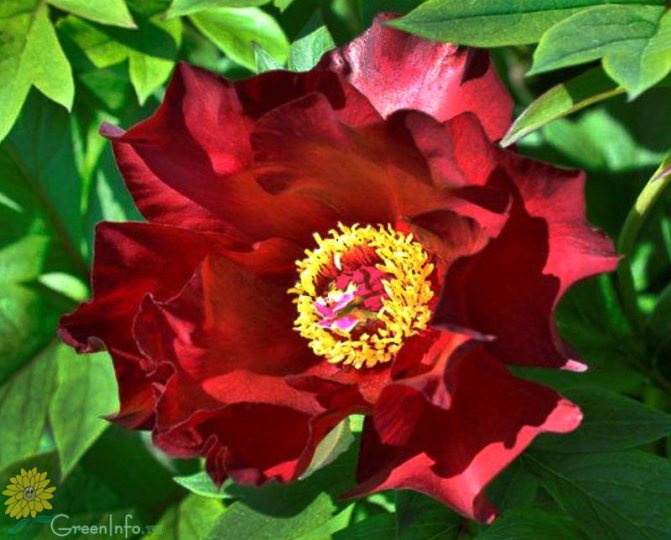

Ito peony Scarlet Heaven / Scarlet Haven / ITOH peony Scarlet Heaven
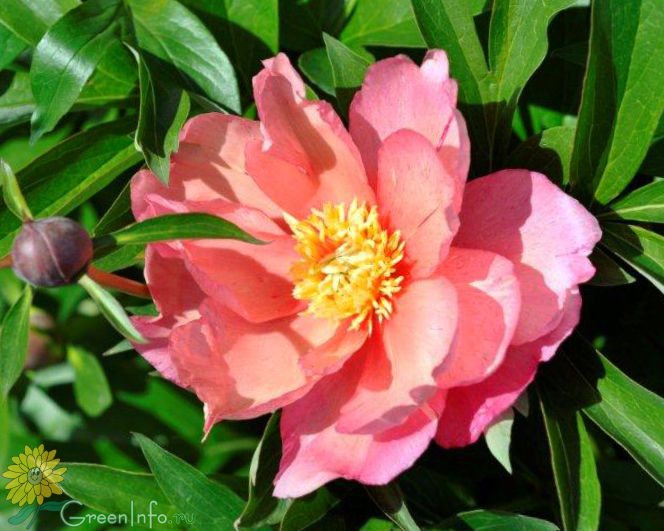

Ito peony Singing in the Rain / ITOH peony Singing in the Rain
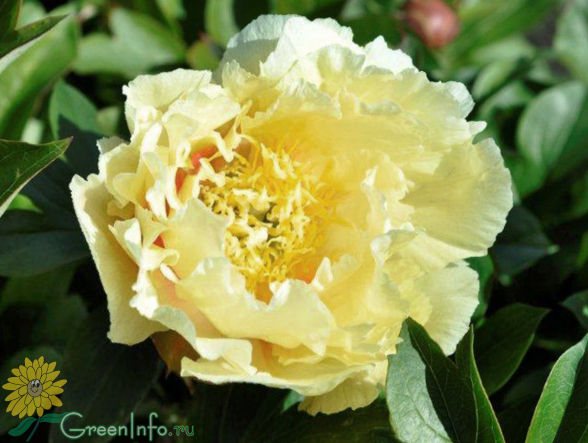

Ito peony Shining Light / ITOH peony Shining Light / Shining Light
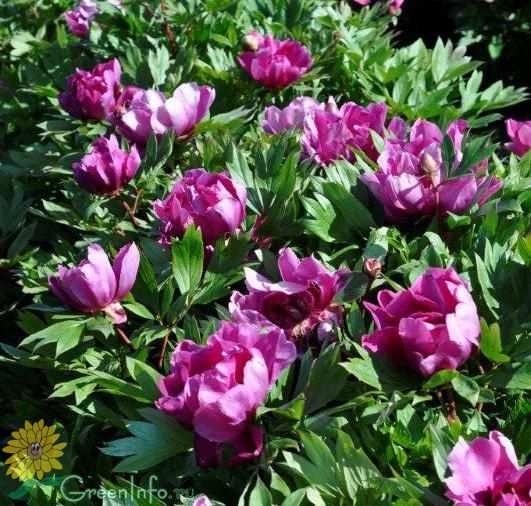

Ito peony Paars / ITOH peony Paars / Paars
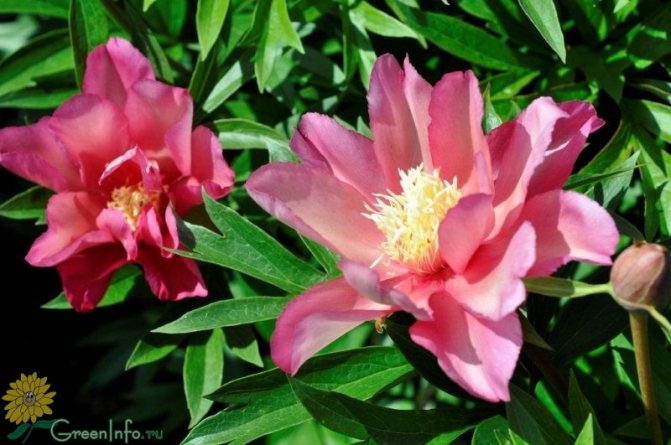

Ito peony Julia Rose / Julia Rose / ITOH peony Julia Rose
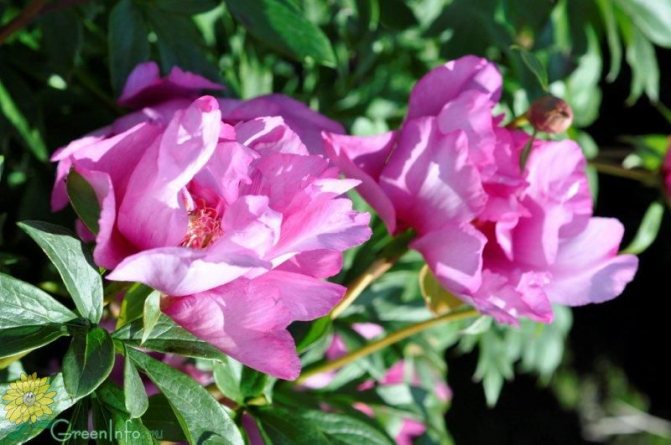

Ito peony First Arrival / ITOH peony First Arrival / Fest Arrival
larisa Russia, Novosibirsk 02/14/2015 00:21
I have not seen such peonies in our gardens .. they are winter-hardy .. I do not cut ordinary peonies to the soil ..
Reproduction
Ito-peonies can only be propagated by dividing the bush. If you use seeds for this, then the plants after germination will be completely different. They will lose their species characteristics.
You can divide the bush only 5 years after planting. Otherwise, the plant may simply die. This can be done both in spring and autumn.
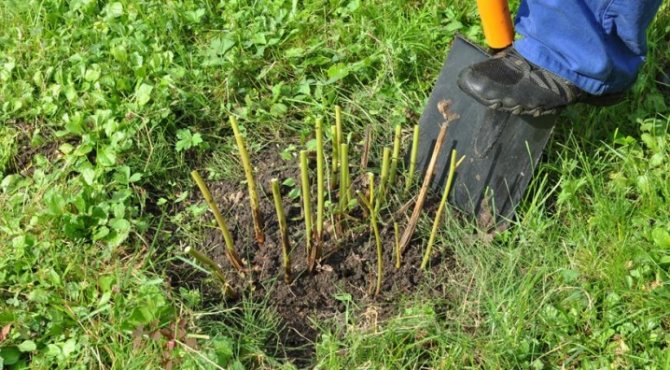

However, deciding to make reproduction in the spring, you must remember that after transplanting at this time, the plant begins to grow very quickly... Therefore, it will not be able to form a sufficient number of roots by the onset of the hot summer, which means it will not be able to provide itself with sufficient moisture. Therefore, in extreme heat, it is necessary to provide peonies not only with timely watering, but also to make a shelter from the scorching rays of the sun.
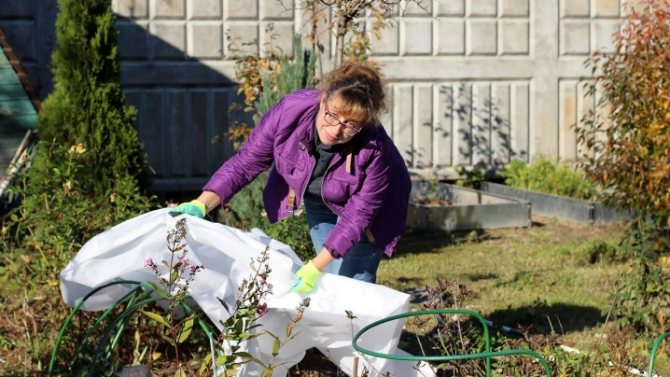

The autumn division of the root system will make it possible for it to get stronger already by the onset of winter, as well as increase the required number of roots, which can easily withstand the cold. It should be done in August or September.
To divide the roots, you need to cut the isthmus first, and then carefully divide the roots. In addition, you need to look so that they are not damaged. In order to cut the isthmus, a very sharp garden knife must be used. All roots should be approximately the same, up to 14 centimeters, and also have several buds. Only in this case the plant has the opportunity to take root.
Immediately after their separation, the roots should be sprayed with a fungicide solution in order to disinfect them in the future.
Having decided to start these unusually beautiful yellow hybrids on your personal plot or in the country, you must definitely familiarize yourself with caring for them, and also decide on the variety. After all, it will depend on this whether they will be able to settle down in a new place or not.
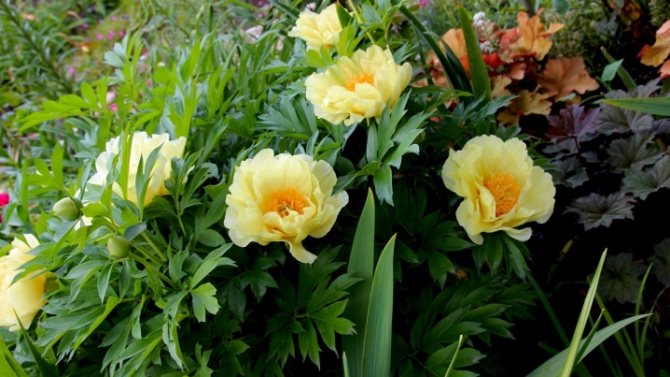

You can learn more about why ito-hybrids of peonies are better than tree varieties, how to properly care for them and how to plant them.
Description
These peonies are quite powerful and large bushes, which are distinguished by strong shoots. Their roots are spreading and are practically on the surface. Over time, they grow stiff and they grow strongly, so it will not be so easy to transplant them. The root system can reach up to 85 centimeters. The height of the bush sometimes reaches 85 centimeters. But despite this, shoots only bend under the weight of the peonies, but do not lie on the ground.
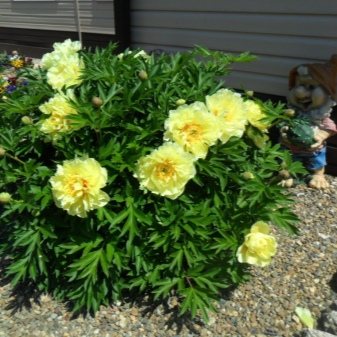

The leaves are similar to those of tree-like peonies - the same carved. In addition, they are more like a green pillow, which can last until the very frost. By autumn, their color changes only in a few varieties.
Flowers of Ito-peonies are also placed at the very tops of young shoots. These are large, up to 16-19 centimeters in circumference, picturesque flowers. They have wavy petals with very delicate patterns. Unopened buds are a bit like chestnuts in shape. Blooming flowers are distinguished by a large number of petals, which have several spots at their base.
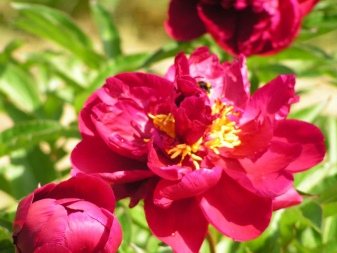

The shades of these hybrids are quite diverse. They can be too bright yellow to light golden in color. Very often they have several transitions from one color to another. Almost all flowers have a tendency to fade, so as they bloom, the petals become paler.
Besides, all hybrids are characterized by instability of shades. One and the same variety in different years can bloom completely differently. Thanks to this feature, the Ito-peony variety was bred. "Chameleon". Some late species begin to bloom after most of the peonies have bloomed and lasts almost a month.
However, there are those in which the appearance of buds begins in April.
Planting hybrid plants in spring and autumn
All varieties of peonies, including hybrid ones, are recommended to be planted in the garden in autumn (from late August to mid-September). As a last resort, you can plant seedlings in spring, in April, having prepared a hole in advance and choosing a suitable place.
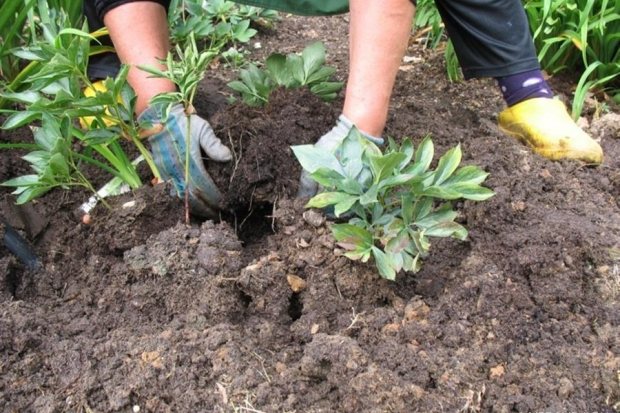

The site must be well lit, protected from drafts and flooding. Lowlands, swampy soil and the vicinity of large trees and shrubs are not allowed. Hybrids grow well on loams with neutral acidity. You need to dig up the soil, add some organic matter, dig holes of 90/90 size and lay a thick layer of drainage on the bottom.
How to choose soil?
On top of the drainage layer, you need to lay a loose nutrient mixture, which is very easy to prepare yourself.
Take:
- humus;
- the same amount of garden land;
- 300 g dolomite flour;
- 200 g superphosphate;
- 250 g of ash.
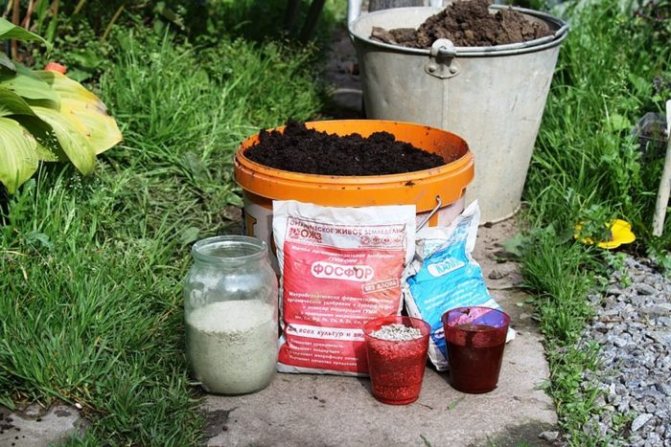

Fill the holes with this mixture by 2/3 of the volume, place the seedling, sprinkle with the remaining soil and tamp.It is important to ensure that the upper root buds are at a distance of 5 cm from the soil surface. Water a young bush abundantly after planting and mulch the soil.
Temperature regime
Hybrids are unpretentious, tolerate frost well and are not afraid of temperature changes. The optimum temperature for growth and flowering is between 20-25 ºС. The main requirements are good illumination and no drafts.
Air humidity
Ito-peonies do not like waterlogging, from which the root system suffers. During the period of heavy rains, special means that protect the roots (Alirin, Gamair) are introduced into the soil around the bush. Dampness is contraindicated for hybrids.
Nutrient dressing for seedlings
The plant begins to feed in the third year after planting. During the growth of the bush, the soil around is sprinkled with wood ash.
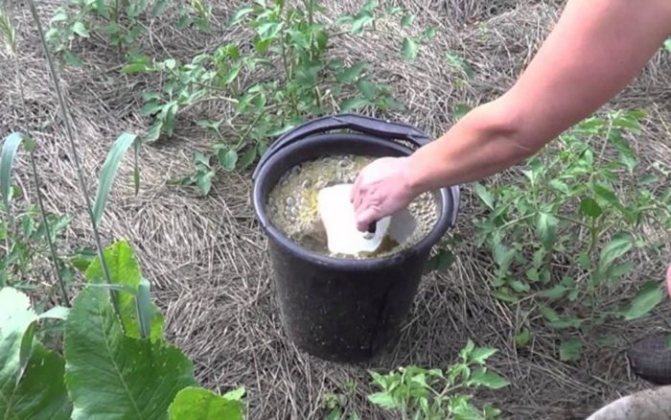

Interesting! In early spring, nitrogen fertilizers should be applied to increase the green mass. After flowering, it is better to apply potassium-phosphorus fertilizing.
How to care for a herbaceous plant?
In the first 2-3 years after planting, you do not need to wait for a rapid flowering from the peonies. On the contrary, buds set during this period should be removed immediately so as not to weaken the development of plants.
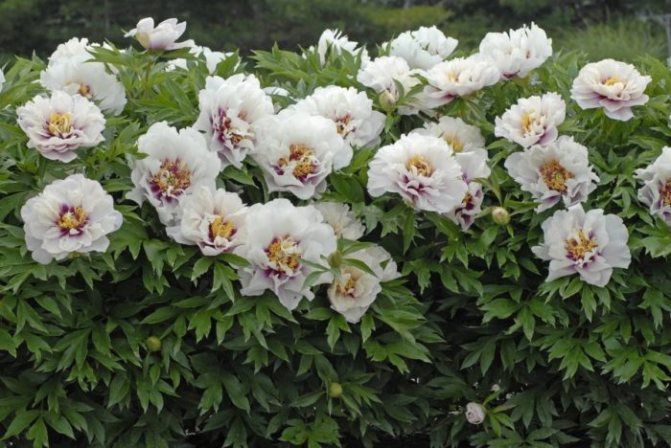

Other rules of care:
- Summer pruning. In mature plants in the second decade of June, dried flowers are removed to stimulate the formation of new buds.
- Autumn pruning. After the onset of stable winter frosts, the ground part of the plant is cut to "hemp" (up to 5 cm). This is necessary to prepare the plant for wintering.
- AID-peonies do not need additional shelter for the winter. Nevertheless, in especially cold years, it is advisable to mulch the flower bed with a layer of straw or rotted manure (15 cm).
You should also pay attention to watering and fertilizing.
Watering
The soil in the flowerbed should remain moist, but not damp. You can determine moisture using a simple test. You need to collect the earth in your palm and clench your fist:
- if the earth wakes up between the fingers, then it is dry and urgently needs watering;
- if the earth sticks together into a lump, but breaks when it falls on the ground, the flower bed needs planned watering;
- if the earth sticks together into a solid lump that does not break when dropped, the moisture level is sufficient.
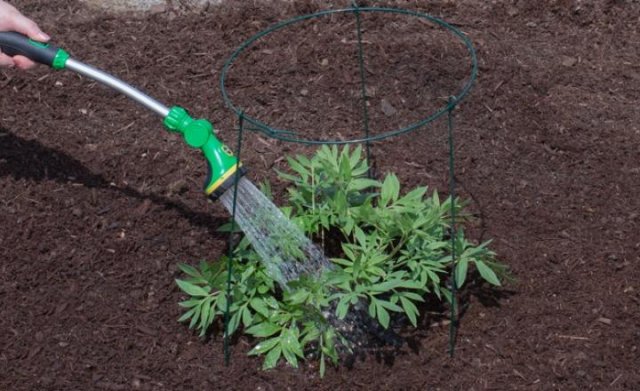

Important! When checking, the composition of the soil must be taken into account. Even a well-moistened sandy soil will not stick well together.
Top dressing
In the first two years, ITO peonies do not need additional nutrients (provided that the soil is of good quality and pruning is carried out).
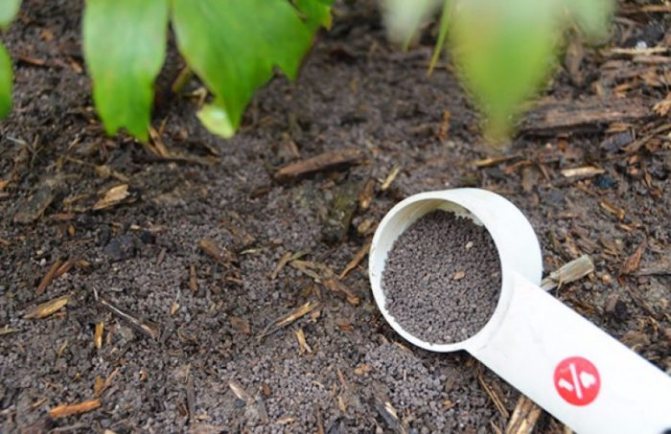

Fertilizers start from the third year:
- in March, 10 grams of nitrogen and potassium are applied under each bush;
- in early June (at the budding phase) - 10 grams of complex fertilizers (NPK);
- at the end of August (during the budding period of renewal) - 15 grams of phosphorus and potassium.
Pests and diseases
ITO peonies are most susceptible to such diseases:
- Gray rot. To combat the disease, use the drug "Tirama". The affected plant parts are cut off and burned.
- Root rot. The affected part of the rhizome is cut off, the healthy part is dug up and treated with potassium permanganate and Fundazol. If the disease has penetrated into the vascular system, the bush cannot be saved.
- Rust and cladosporium. When symptoms are detected, diseased leaves and stems are removed, and the remaining ones are treated with Bordeaux mixture.
- Powdery mildew. Affected bushes are sprayed with soda ash, copper sulfate, Quadris or Topaz fungicides.
When to start preparing for winter by region


Pruning, feeding, pest and disease control is the first step in preparing this perennial for winter. It is important, according to all the rules, to cover peonies for the winter so that they do not freeze out. This procedure is especially relevant in those regions where winters are long, with little snow and very cold. In different regions, the timing of the preparation of peonies for winter differs due to the different timing of the onset of frost.
In outskirts of Moscow
In the Moscow region, the preparation of peonies for winter begins from the first days of October and ends in the last days of this month. All work must be completed 2 weeks before the onset of stable cold weather.
In the Urals
All preparatory work in the Urals is completed by mid-October. At the same time, the bushes should be well wrapped in order to painlessly endure the cold winter.
In Siberia
In Siberia, the preparation of peonies for winter continues until early October. All work must be completed before the onset of stable frosts. When carrying out work, you need to focus on weather conditions. Shelter of bushes is carried out only in dry weather.
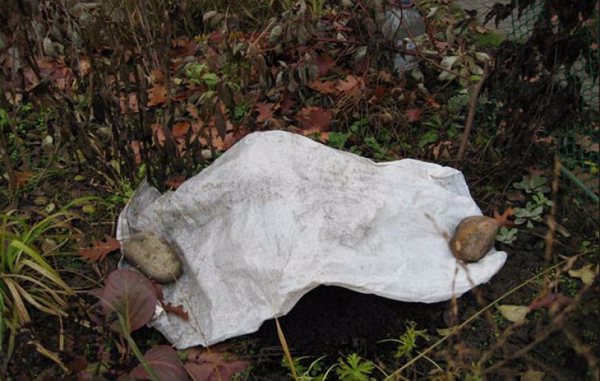

In the Leningrad region
Work on the preparation of peonies for winter in the Leningrad region ends at the end of October. If it is a warm autumn, then they can be extended until the first days of November.
Distinctive features
Ito-hybrids of peonies were obtained by crossing treelike and herbaceous varieties. Their main features include:
- winter hardiness;
- the ability to grow rapidly;
- the dying off of foliage in the fall;
- abundant and long flowering;
- undemanding lighting.
Ito-peonies begin to bloom 2-3 years after planting. However, their first buds are usually not very beautiful - they have an irregular shape, curved petals. But a year after the appearance of the first flowers, everything returns to normal and the plant pleases its owners with a luxurious appearance. The maximum beauty, according to most gardeners, these hybrids are gaining at 4-5 years of development.
With a close occurrence of groundwater, Ito-pions are planted in elevated natural or artificially arranged areas. It is not recommended to place these flowers next to shrubs or trees. Otherwise, they will lack nutrients.
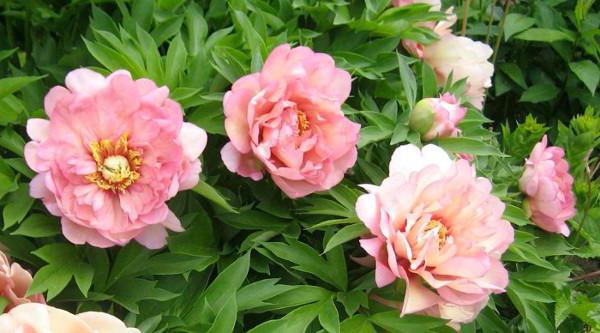

Gardeners reviews
Elena: “Peony Yellow Crown disappointed. Flowers bloom late and are in the depths of the bush so that they are almost invisible. "
Alexandra: “Hillary was jailed three years ago. Every year he pleases more and more. Firstly, the flowers are very large and fragrant, and secondly, the reverse side of the petals is lighter, which is very interesting when viewed from the side. "
Marina: “All ITO-shki are very beautiful. I especially like Border Charm. Just keep in mind that for the first 2 years the bush will be very small - about 40 cm, with 2-3 flowers. But then it will turn into a real handsome man! "
5 / 5 ( 2 votes)
When and how to prune peonies: video
Peonies, when well cared for and sheltered in winter, thrive in spring and bloom luxuriantly. These bright and beautiful flowers envelop the entire garden with their aroma, delighting everyone without exception.
Autumn foliage of peonies can be a real decoration of the autumn garden. The leaves gradually turn golden, and then purple tones, in tune with the crimson of ripening apples. This phenomenon can be observed during a warm autumn and a long absence of frost. Therefore, you should not rush to prune peonies, but you still need to choose the time in order to correctly and profitably transfer them to winter mode. The timing and technique of pruning will depend on what kind you need to prepare for winter: grassy, tree-like or ito-hybrids.
Read also: Planting orchids in expanded clay video
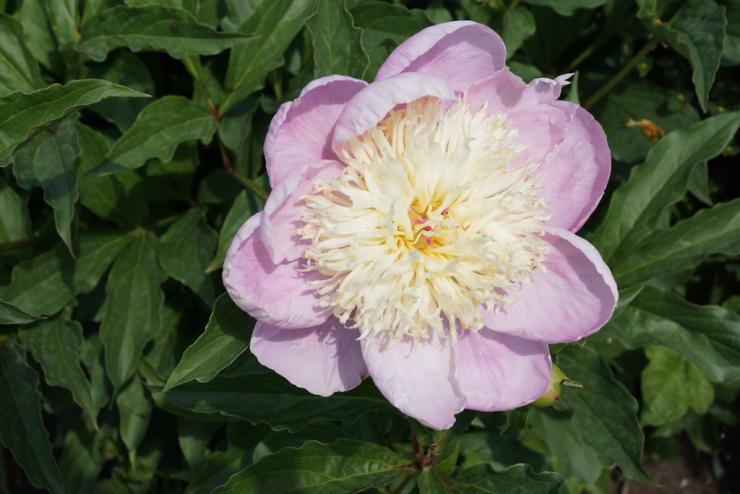

Pruning herbaceous peonies
Herbaceous peonies are distinguished by a special ability to bright autumn coloration in the Moscow region.


Herbaceous peonies with sick - dried or withered foliage, as well as with dark spots on the leaves - are cut off as early as possible, in early September. Pruning such foliage is done as it appears. If the plants have healthy foliage, do not rush to prune. During the fall, there is an outflow of nutrients from the leaves into the rhizome. The later the leaves are cut, the stronger the bushes and flower stalks will be for the next year.
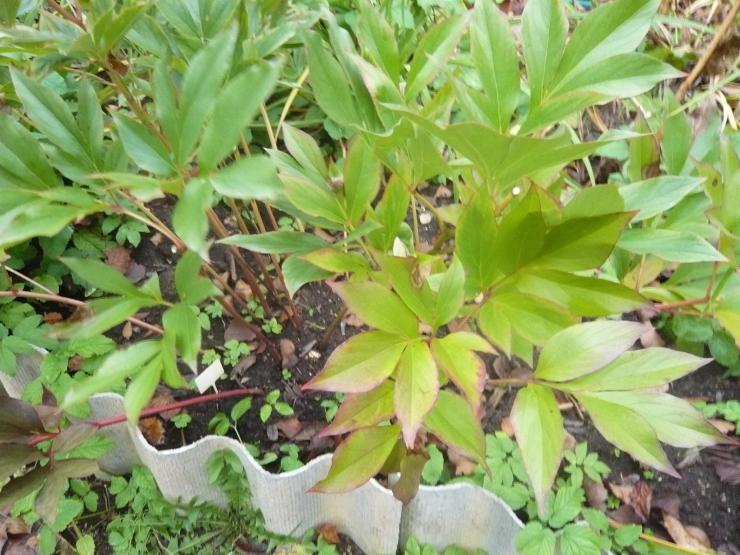

In the Moscow region, peonies are cut from mid to late October. In the absence of frost, the leaves feed the rhizome until they die completely, when they completely lie on the ground.After freezing temperatures, sluggish leaves are cut off the next day.
When pruning peonies, the secateurs are kept level and parallel to the ground. It is believed that moisture and frost penetrate the rhizome through the cuts of the hollow stems, reducing its frost resistance, so it is undesirable to leave hemp.
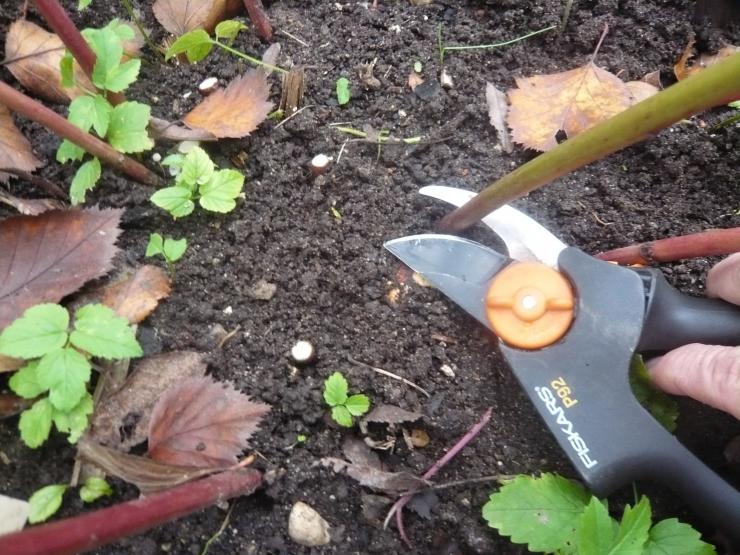

After pruning, the soil is sprinkled evenly with ash and mulched with a 10 cm layer of humus or compost. Thus, the hollow stems will be reliably protected from frost and will receive additional nutrition in early spring. If the leaves of the peonies had a sick appearance or withered prematurely, after trimming the planting, it is necessary to spill it with a phytosporin solution from a watering can with a strainer.
Pruning ito-hybrids of peonies
Ito-hybrids of peonies retain a rich green color until the very snow. Such peonies can form buds on stems at a height of 10-15 cm, and when pruning, the question arises of what to do with them. Usually there are few such buds - from 3 to 7 pieces per bush. The first years I tried to preserve them, however, in the conditions of the Moscow region, it is impossible to do this - they freeze out under any shelter. You should not be upset about this, such superficial buds do not affect either flowering or the formation of a bush. Rather, they are formed from a good life.
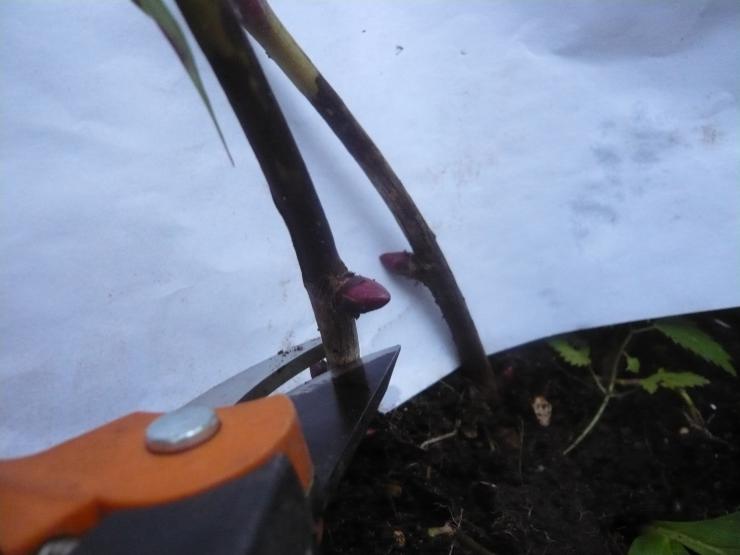

Ito hybrids are pruned in the same way as herbaceous ones, according to the soil level. Unlike grassy ones, their buds next year protrude slightly above the ground, so when pruning, you need to be careful not to accidentally cut off their tops.
Pruning of ito-hybrids is performed before the onset of the first frost. After pruning, the ground is immediately mulched - to protect the flower buds from frost. Spend half a bucket per bush.
Pruning tree peonies
Tree peonies, like ito-hybrids, stand green for a long time, without losing their summer color until cold weather.
Pruning of tree-like peonies is done before the shelter for the winter, when the sub-zero temperature is 5-7 ° C at night. Keep in mind that flowers should be under a non-woven fabric before pruning in case the temperature drops too low at night. After all, the flower buds of the next year are located in the axils of the leaves, and it is important that they do not fall under frost.
In tree-like peonies, all the leaves are carefully cut off from the trunk, after which a winter shelter is built. As a rule, such an operation in the Moscow region falls on the beginning of November.
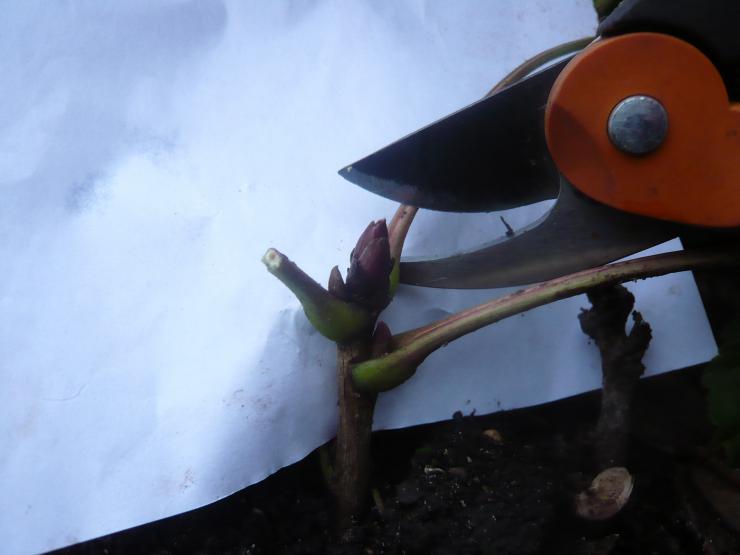

Pruning peonies in autumn (video)
The beginning of the third decade of September is the time for pruning herbaceous peonies and feeding the peonies. Ito hybrids and trees are pruned directly in front of the shelter, but fed in the same way as grassy ones. The purpose of the fall feeding is to help the plants prepare for winter and endure all its surprises. During such feeding, I try to provide the plants with a powerful start for the spring.
Adding an article to a new collection
Peonies have long been prized by gardeners around the world for their lush foliage and large showy flowers. They appeared in culture more than one and a half thousand years ago and since then many new forms, colors and sizes of these beautiful perennials have been bred. Is it really possible to create something else new?
Yes, until now, breeders continue to delight connoisseurs of peonies with new improved varieties and hybrids. Today we will talk about the unusual result of crossing herbaceous and tree-like peonies, about ITO-hybrids (Itoh hybrids, or Itoh Group), which saw the light in the middle of the last century.
ITO-peony Garden Treasure (Garden Treasure, Yellow Treasure)
Medium late flowering variety. American selection, originator - Holingsworth, 1984
The variety has received many awards.
Herbaceous perennial, prefers semi-shaded places (quickly fade in the sun). Frost resistance zones 4-8. The height of the bush is about 80-90 cm, the plant is dense, with strong shoots, it grows rapidly (more in breadth than in height). The leaves are dark green, strongly dissected, slightly shiny.
The flowers are semi-double, large (about 20-25 cm in diameter), creamy yellow with red-orange strokes in the center.The petals are straight, wide, slightly indented. Flowers bloom in turn. Lemon aroma. Flowering duration is 0.5-1 month.
Flowers stand well in cut. The plant is resistant to urban conditions, most diseases and pests.
Among all the variety of varieties of ITO-peonies, it is truly difficult to single out the very best. Each ITO hybrid has its own advantages - in terms of unpretentiousness, color, flowering duration, flower size, etc. We hope that our article with a description and photos of the most popular peonies according to gardeners will help you make this difficult choice.

